The pear tree, scientifically known as Pyrus, is a sight to behold. With its elegant, slender branches reaching skyward, it boasts glossy, serrated leaves that shimmer in the sunlight. This deciduous wonder comes to life in spring, adorned with clusters of delicate, aromatic flowers that transform into succulent fruits. The varieties of pears are vast, from the crisp and juicy Bartlett to the buttery smoothness of Bosc. Its burst of flavors truly sets it apart, ranging from honey-sweet to tangy and refreshing. This tree, often medium-sized, is hardy and can withstand various climates, making it a favorite among gardeners.
The pear tree has traversed the globe, finding its roots in different continents. The Asian pear, originating in China and Japan, is renowned for its crisp texture and unique, round shape. European pears, including the well-loved Bartlett and Anjou varieties, hail from the temperate regions of Europe. Additionally, there are hybrid varieties that combine the best of both worlds, creating a delightful fusion of flavors and textures. This tree thrives in well-drained soils and temperate climates, symbolizing resilience and adaptability.
Beyond its irresistible taste, the pear tree has woven itself into the cultural fabric of societies worldwide. From delectable jams and desserts to refreshing beverages, pears offer a myriad of culinary delights. In folklore and literature, they often symbolize longevity, prosperity, and wisdom, making them a cherished motif in many cultures. Moreover, with its fine grain and durability, pear wood finds application in crafting exquisite furniture and musical instruments, adding to the tree’s versatility.
As a master gardener, my fascination with pear trees has grown immensely. In this guide, I’ll unveil the secrets of pear trees, acquired through years of dedicated research and hands-on experience. From their graceful appearance to their diverse varieties and delightful flavors, I’ll provide you with all the essential information you need to know about pear trees. Plus, I’ll share expert care tips, ensuring you can easily nurture these magnificent trees and watch them flourish in your garden.
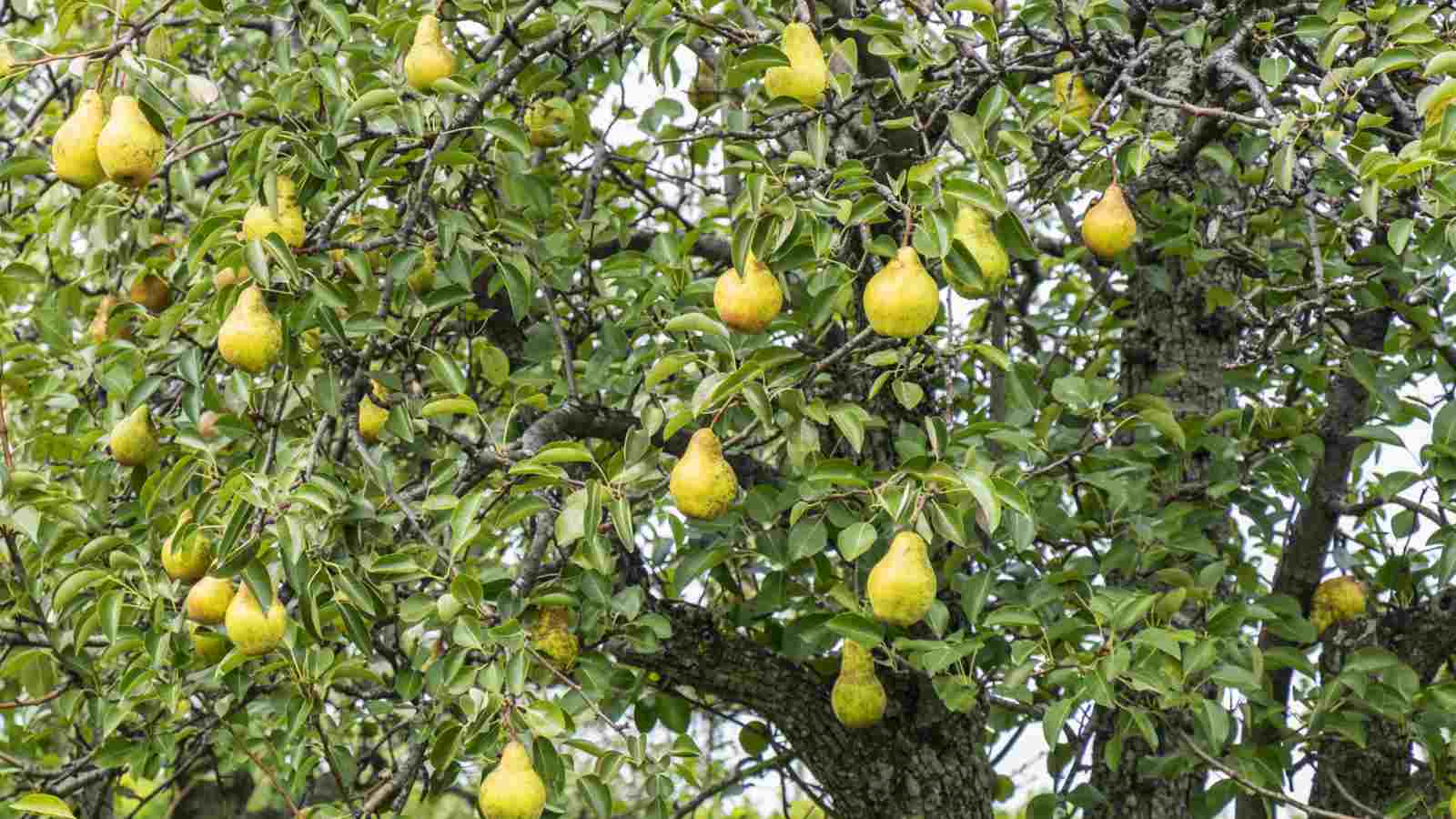
Botanical Name: Pyrus
Common Name: Pear Tree
Family: Rosaceae
Plant Type: Deciduous Tree
Hardiness Zones: 5-9 (USDA)
Sun Exposure: Full sun to partial shade
Soil Type: Well-draining soil, preferring loamy or sandy texture.
Soil pH: 6.0-7.5 (Slightly acidic to slightly alkaline soil)
Maturity: Within 4-6 years after planting
Height: Between 15 to 30 feet (4.5 to 9 meters) tall
Spacing: 20 to 25 feet (6 to 7.5 meters) apart
Bloom Time: Early spring, usually from April to May
Flower Color: White
Native Area: Europe and Western Asia
Pear Tree Care
Caring for pear trees is an art that involves a blend of patience, knowledge, and a deep appreciation for nature’s cycles. When planting your pear tree, select a spot that receives full sun to partial shade. Pear trees require at least 6 hours of direct sunlight daily for healthy growth. Proper placement ensures the tree gets the sunlight it needs to photosynthesize and develop robust fruits.
Pear trees prefer well-draining soil, rich in organic matter. Loamy or sandy soils are ideal, allowing excess water to drain away and preventing root rot. Before planting, amend the soil with compost or well-rotted manure to enhance its fertility and drainage capabilities.
Adequate watering is crucial, especially during the tree’s early years. Provide consistent moisture, ensuring the soil remains evenly moist but not waterlogged. Deep, infrequent watering encourages the tree’s roots to grow deep, making it more resilient during dry spells.
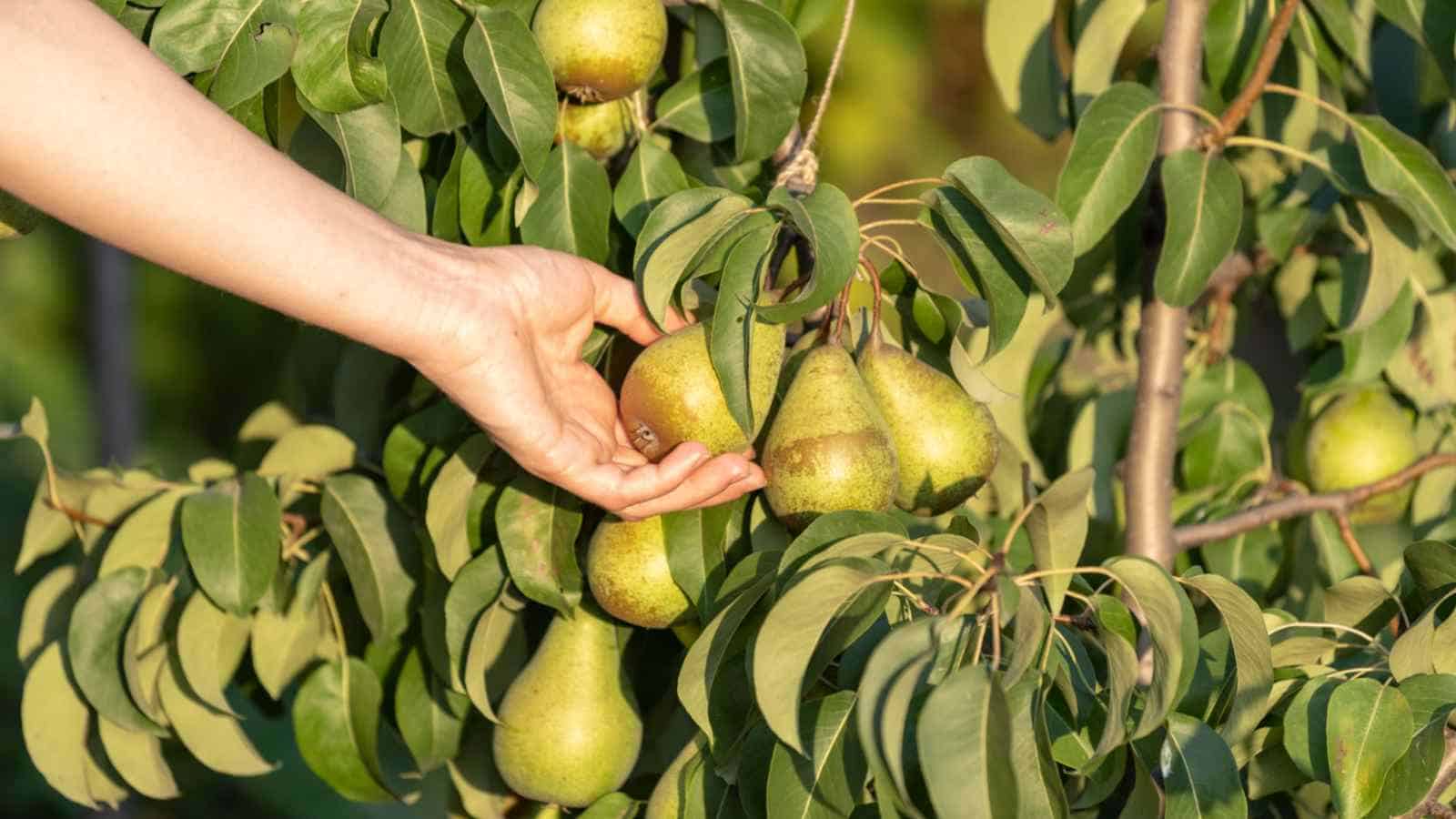
Regular pruning is essential to shape the tree, remove dead or diseased branches, and improve air circulation. Prune during the dormant season to stimulate new growth in spring. Additionally, consider training young pear trees into a central leader shape, which promotes a strong, balanced structure.
Pear trees benefit from regular fertilization, particularly in the spring, as they enter their active growth phase. Use a balanced, slow-release fertilizer to provide essential nutrients. Be mindful not to over-fertilize, as excessive nutrients can harm the tree rather than benefit it.
Keep a watchful eye for common pests like aphids and pear psylla and diseases such as fire blight and powdery mildew. Implement organic pest control methods and, if necessary, consult with a local horticulturist for targeted solutions. Regularly inspect the tree to catch any issues early.
By providing your pear tree with the right environment, proper care, and attention, you’ll enjoy the beauty of its blossoms and savor the sweetness of its fruits, making your gardening journey truly rewarding.
Light
Light is a fundamental factor influencing the health and productivity of pear trees. These trees, like many fruit-bearing plants, thrive in abundant sunlight. Adequate light exposure is essential for photosynthesis, where the tree converts sunlight into energy, enabling it to grow, blossom, and bear fruit. Pear trees should be planted in locations that receive full sun to partial shade. Full sun, which provides at least 6 hours of direct sunlight daily, benefits robust growth and bountiful fruit production.
In partial shade, pear trees can still flourish, although it might affect the intensity of flowering and fruiting. When selecting a planting site for your pear tree, consider the natural light patterns in your garden, ensuring the tree receives the necessary sunlight to thrive. Regular observation of the tree’s response to light conditions can guide your decisions, ensuring your pear tree enjoys optimal light exposure for its overall well-being.
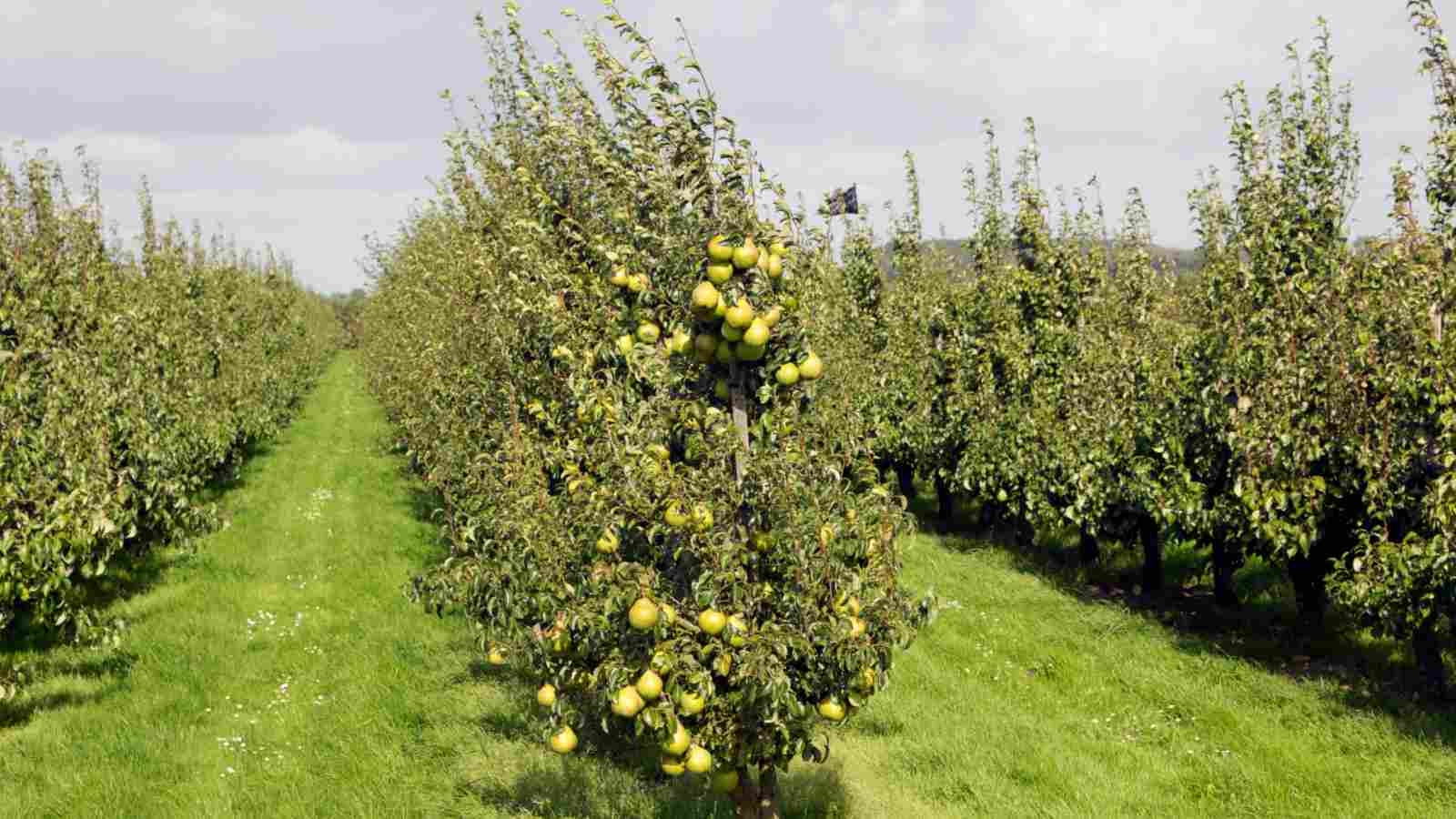
Soil
Pear trees thrive in well-draining soil that balances retaining moisture and allowing excess water to flow away. Loamy or sandy soils are ideal choices, as they prevent waterlogging, which can lead to root rot. Before planting, it’s advisable to test the soil’s pH level. Pears prefer slightly acidic to slightly alkaline soil, with an ideal pH range between 6.0 to 7.5. Adding agricultural lime can help balance the pH if your soil is too acidic. Incorporating organic matter, such as compost or well-rotted manure, enriches the soil, enhancing its fertility and ensuring a steady supply of nutrients to the growing tree.
When preparing the planting site, ensure the soil is loose and well-aerated. Compacted soil can impede root growth, affecting the tree’s overall health. Consider tilling the area to break up compacted layers to improve soil structure. Mulching around the base of the tree conserves moisture and enriches the soil as the organic mulch breaks down over time. This natural mulch acts as a buffer, regulating soil temperature and moisture levels, creating an optimal environment for the pear tree’s roots to thrive.
Additionally, regular soil maintenance is key to sustaining a healthy pear tree. Periodic testing of soil nutrients allows for precise fertilization, ensuring the tree receives the essential elements it needs. By providing the right soil conditions, you set the stage for your pear tree to flourish, producing an abundance of luscious fruits season after season.

Water
Understanding the specific water needs of your pear tree is fundamental to its overall health and productivity. Adequate and consistent watering is pivotal in ensuring the tree’s roots receive the moisture essential for growth.
Young Pear Trees:
Newly planted pear trees require careful attention to establish deep, robust root systems. Water young trees deeply at least once a week, ensuring the soil around the tree is moistened to a depth of about 12 to 18 inches. This encourages the roots to grow downwards, providing stability and access to groundwater.
Mature Pear Trees:
Once your pear tree matures, it still requires regular watering, especially during dry spells. Deep watering every 10 to 14 days, depending on the weather and soil moisture levels, is generally sufficient. Focus on delivering water directly to the tree’s root zone to prevent wastage and encourage the roots to expand outward.
Watering Techniques:
Drip irrigation or a soaker hose system is highly effective for pear trees. These methods deliver water slowly, allowing it to penetrate the soil deeply without causing runoff. Applying mulch around the tree’s base also helps retain soil moisture and regulates temperature, reducing water evaporation.
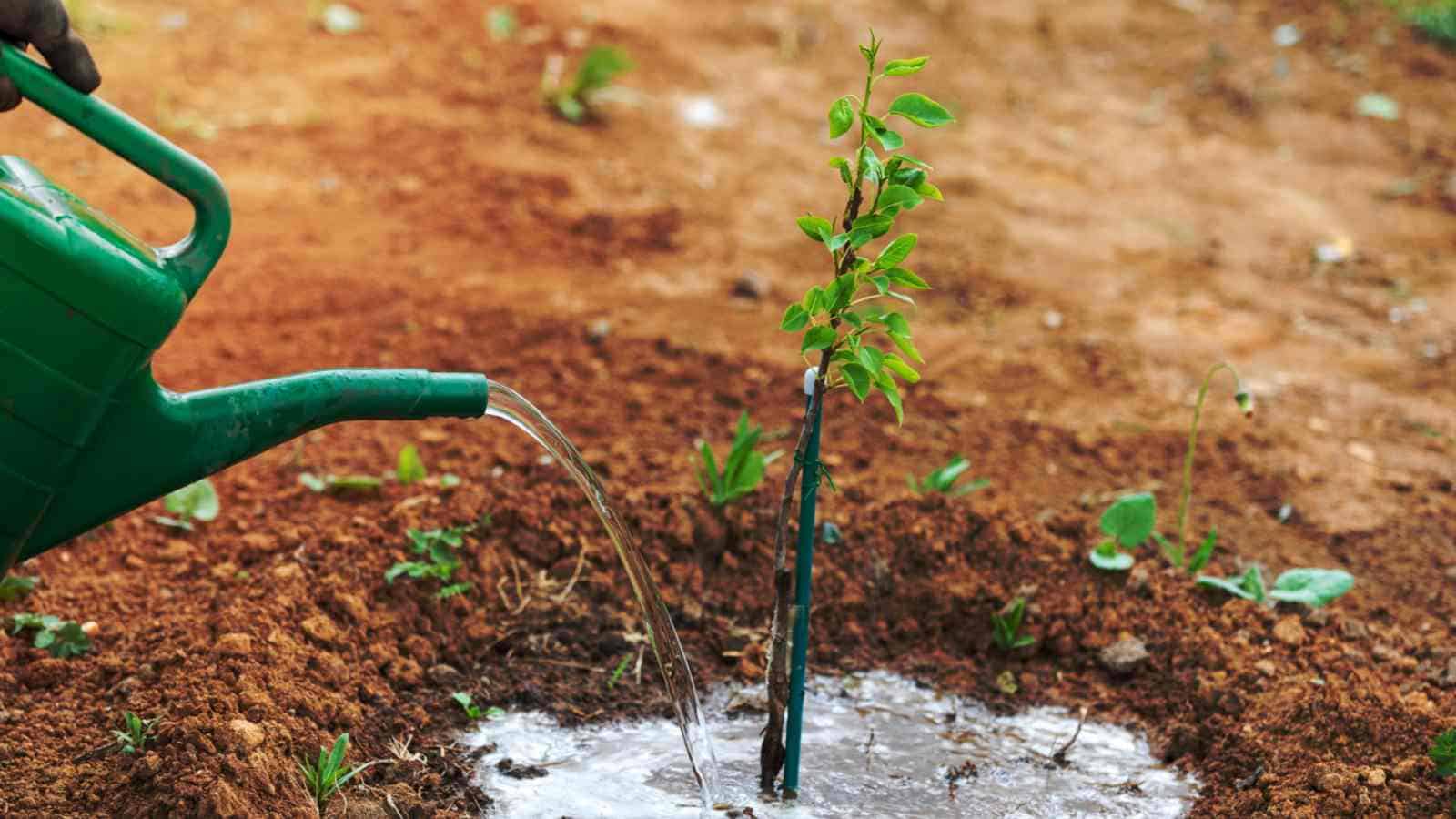
Signs of Overwatering and Underwatering:
Understanding the signs of overwatering, such as yellowing leaves and waterlogged soil, as well as underwatering, like wilting leaves and dry soil, is crucial. Regularly monitoring your tree’s condition allows you to adjust your watering practices, ensuring the right balance for healthy growth.
Rainfall Considerations:
During periods of consistent rainfall, adjust your watering schedule accordingly. Overwatering during rainy seasons can lead to root suffocation and diseases. Conversely, supplementing with additional watering during dry spells ensures your pear tree receives sufficient moisture to thrive.
Temperature and Humidity
Pear trees are remarkably adaptable to various temperatures, thriving in temperate climates. They typically require a chilling period during winter, with temperatures between 32°F to 45°F (0°C to 7°C), allowing them to break dormancy and produce blossoms in spring. However, some pear varieties, especially those from warmer regions, have lower chilling hour requirements, making them suitable for milder climates.
In terms of humidity, pear trees, like many fruit-bearing plants, prefer moderate humidity levels. While they can tolerate various humidity conditions, consistent moisture in the air, especially during the flowering and fruit-setting stages, is beneficial. Adequate humidity aids in the pollination process, ensuring a higher fruit yield. However, excessive humidity can also invite fungal diseases, so it’s crucial to maintain a balance.
It’s worth noting that specific pear varieties might have nuanced temperature and humidity preferences. Therefore, consulting local gardening resources or nurseries can provide tailored insights based on your location. Monitoring weather patterns and adjusting care practices will help you create an optimal environment for your pear tree’s growth and overall well-being.

Fertilizer
Fertilizing your pear tree is a nuanced process that demands attention to timing, formulation, and the tree’s individual needs. Generally, a balanced fertilizer with a composition like 10-10-10 or 14-14-14 provides the essential nutrients—nitrogen, phosphorus, and potassium—necessary for robust growth and fruiting. Applying fertilizer during the tree’s dormant season is crucial, typically in late winter or early spring. This timing lets the tree absorb nutrients effectively, promoting healthy foliage and fruitful branches. Organic options like compost and well-rotted manure also offer valuable nutrients while enhancing the soil’s structure, supporting the tree’s overall health.
Regular observation is key to ensuring your pear tree’s well-being. Adjusting the fertilizer regimen might be necessary if signs of nutrient deficiency appear, such as yellowing leaves. It’s essential to avoid over-fertilization, as it can harm the tree and disrupt its natural balance. Following recommended dosage guidelines, conducting periodic soil tests, and adequate watering after fertilization are fundamental practices. By carefully attending to your pear tree’s fertilizer needs, you contribute to its vitality, ensuring a flourishing and fruitful addition to your garden landscape.
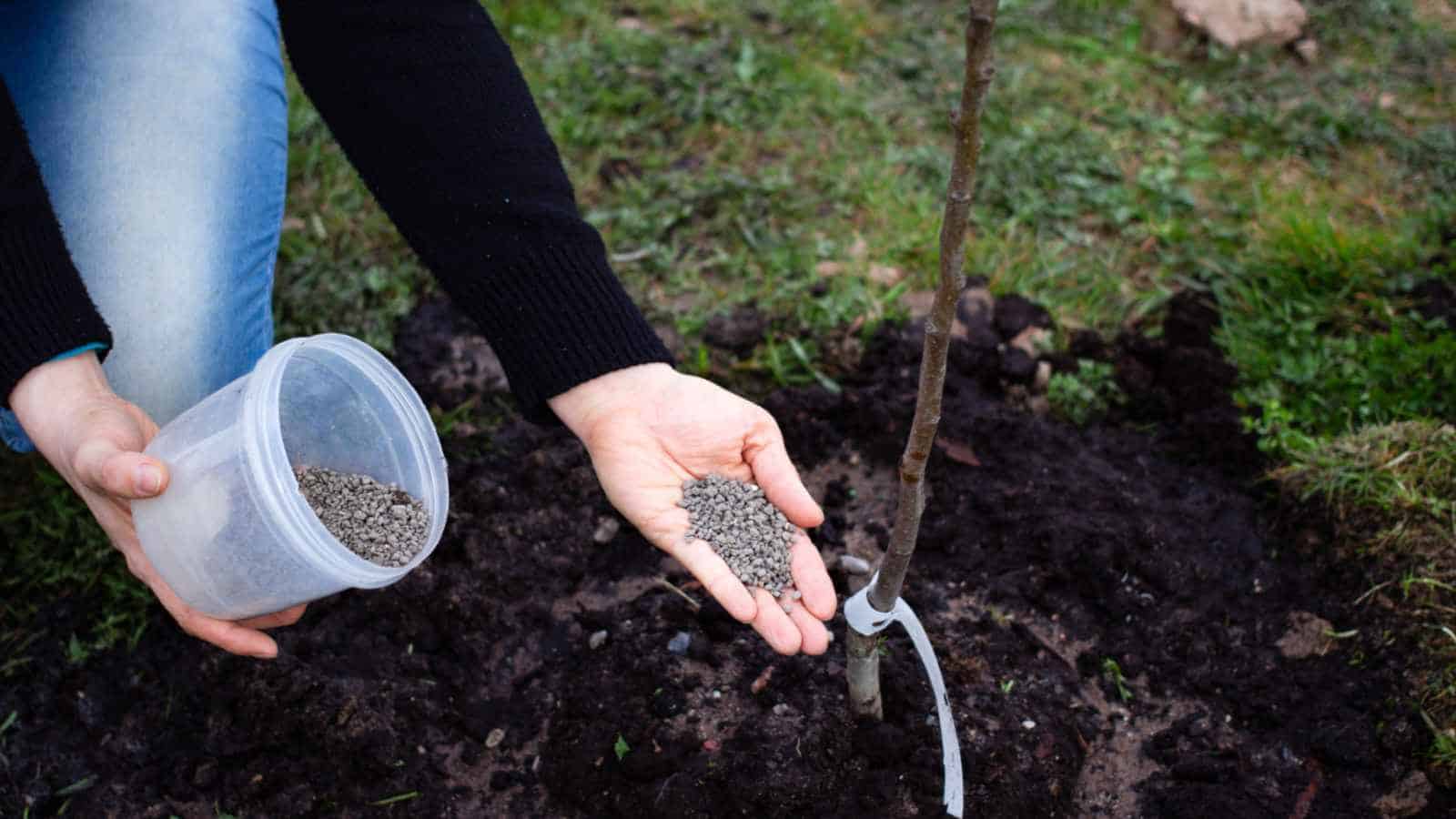
Pruning
Pruning is essential to pear tree care, contributing significantly to its health and productivity. Proper pruning begins with removing dead, damaged, or diseased branches, promoting overall tree vigor. Young pear trees require formative pruning to establish a sturdy scaffold structure, focusing on a central leader and eliminating competing branches. Regular maintenance pruning involves thinning crowded areas, removing water sprouts, and addressing crossing or rubbing branches.
Timing is crucial in pruning. Optimal periods for pruning pear trees are late winter to early spring, during the dormant season. Pruning during this time minimizes stress on the tree and reduces the risk of diseases. Using sharp, clean tools for precise cuts is essential, allowing the tree to heal quickly and preventing unnecessary harm. Each pruning cut should be made carefully, promoting sunlight penetration and air circulation within the tree, vital for robust growth and a fruitful harvest.
Every pear tree is unique, and pruning strategies should be tailored to the tree’s specific growth habits and shape. Thoughtful and regular pruning not only enhances the tree’s aesthetics but also ensures a thriving, productive pear tree in your garden. By understanding and implementing these pruning requirements, you can nurture a healthy, flourishing pear tree that graces your garden with its beauty and bounty.
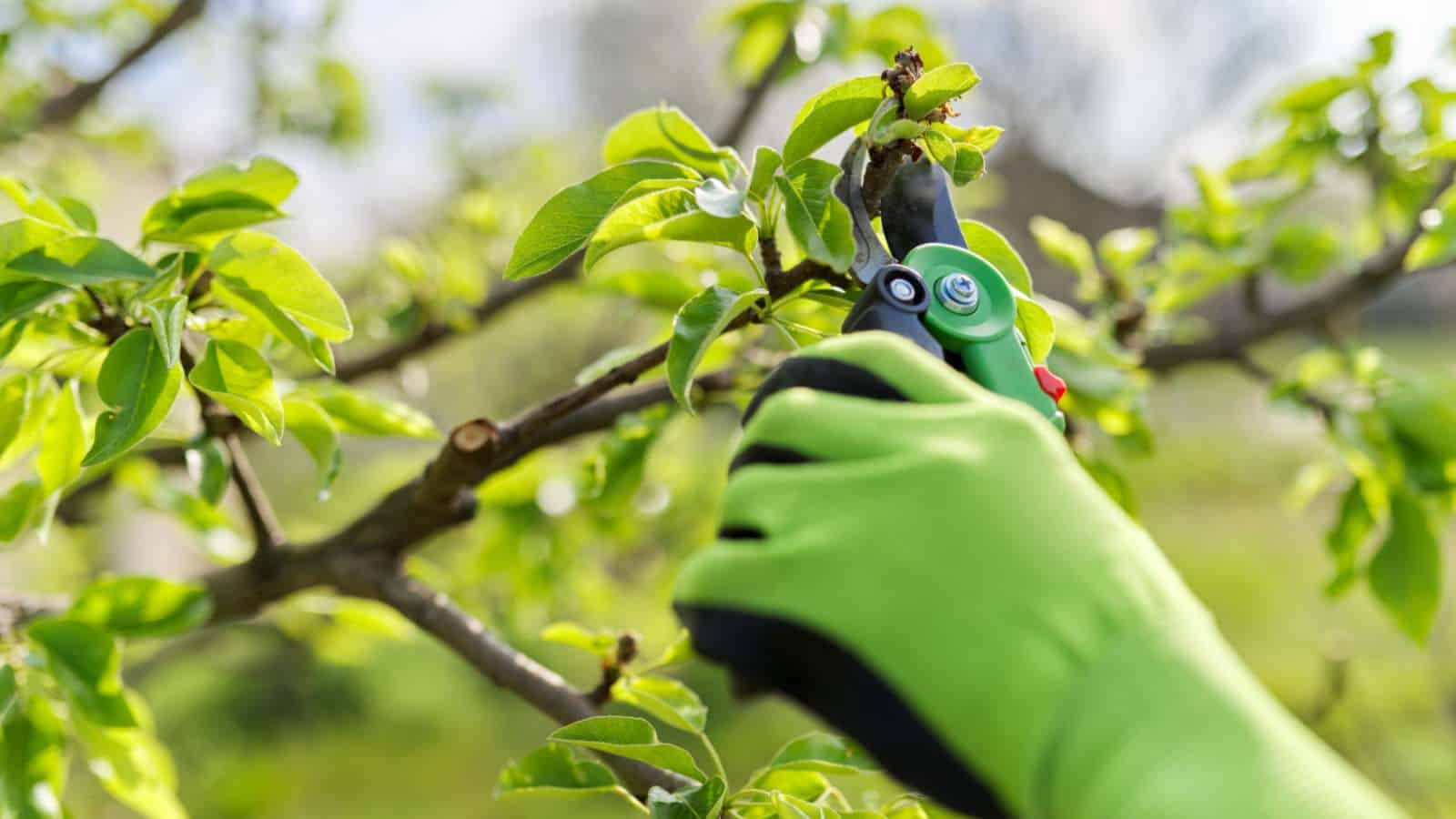
Overwintering
Overwintering pear trees involves protective measures to shield them from the harsh winter conditions, ensuring their vitality in the coming seasons. Before the first frost, thoroughly water the tree to hydrate its roots. Apply a layer of mulch around the base, extending it to the tree’s drip line to insulate the soil and regulate temperature.
Wrapping the lower trunk with tree guards protects against rodents and frost cracks. Consider employing burlap screens or anti-desiccant sprays to shield the tree from cold winds and prevent moisture loss through leaves. Regularly inspect your pear tree during winter, promptly removing any snow buildup on branches to prevent breakage. These simple steps provide essential protection, ensuring your pear tree emerges robust and ready for a flourishing spring.

Types of Pear Trees
The world boasts over 3,000 pear tree varieties, yet only a portion of these are cultivated in the United States. This limited selection simplifies which pear tree to grow in your yard. However, before making a decision, it’s essential to consider a few factors. Determining the most suitable pear tree variety for your specific climate is paramount. Certain varieties excel in colder regions, while others thrive in warmer environments. Here are some cultivars of the pear tree:
Bartlett Pear
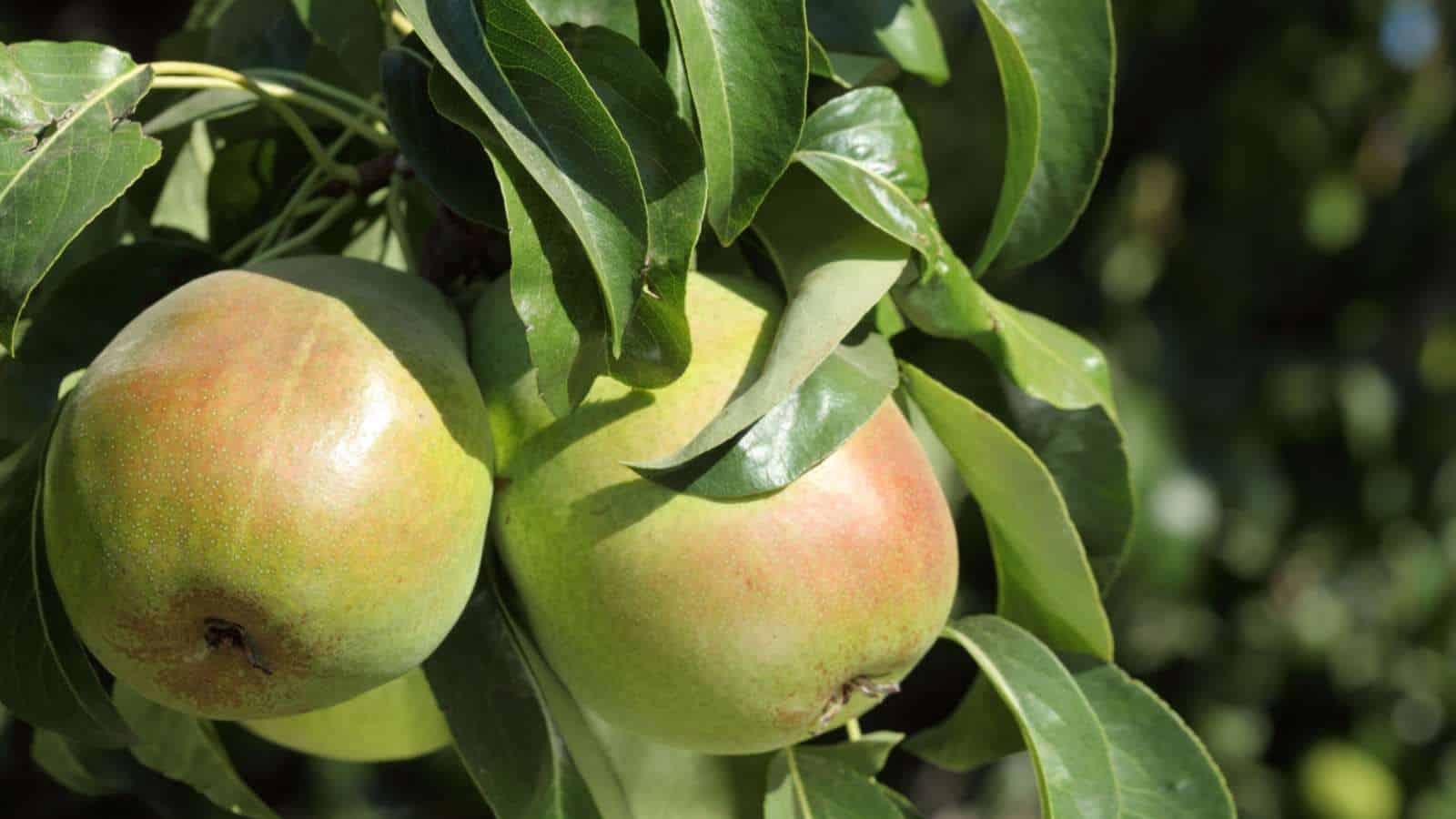
- Botanical Name: Pyrus communis ‘Bartlett’
- USDA Hardiness Zones: 5-7
- Mature Size: 12-20 feet tall, 10-15 feet wide
- Light: Full sun
- Soil: Well-drained, loamy soil
The Bartlett pear, also known as the Williams pear, is renowned for its classic pear shape and bright yellow skin. Its flesh is juicy, sweet, and ideal for fresh eating, canning, or baking. Bartlett pears thrive in moderate climates and produce abundant fruit, making them a favorite for home orchards.
Baldwin Pear
- Botanical Name: Pyrus communis ‘Baldwin’
- USDA Hardiness Zones: 5-8
- Mature Size: 15-20 feet tall, 12-15 feet wide
- Light: Full sun to partial shade
- Soil: Well-drained, fertile soil
Baldwin pears are prized for their large, golden fruit with a sweet and juicy flavor. These pears are versatile and can be enjoyed fresh, in salads, or for making preserves. They thrive in a range of climates and are known for their hardiness.
Kieffer Pear
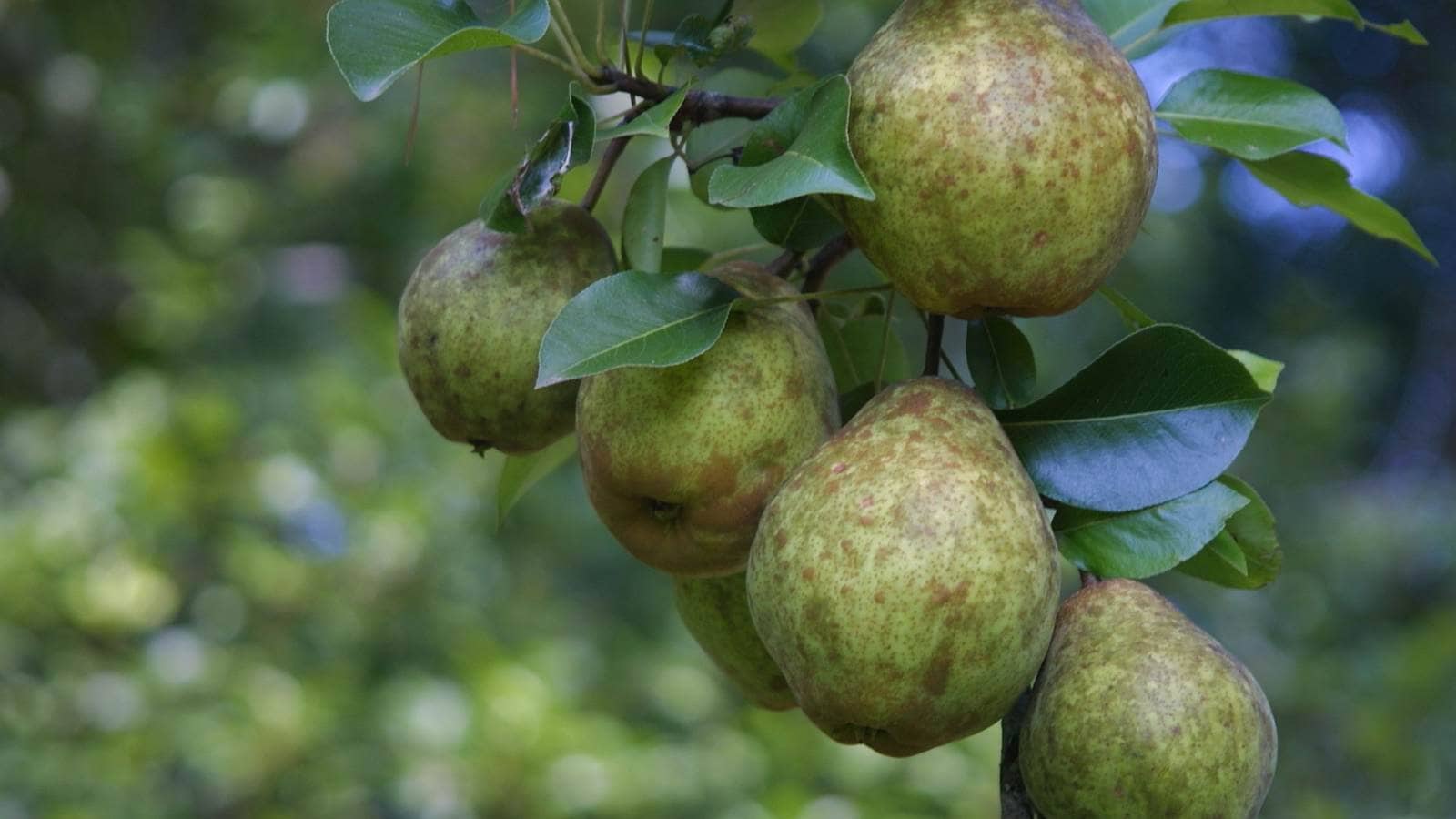
- Botanical Name: Pyrus calleryana ‘Kieffer’
- USDA Hardiness Zones: 4-9
- Mature Size: 20-30 feet tall, 12-20 feet wide
- Light: Full sun
- Soil: Well-drained, adaptable to various soil types
Kieffer pears are robust and suited for a wide range of climates. They have a coarse, gritty texture but are excellent for canning and baking. The fruit mixes yellow and green and offers a mild, sweet taste.
Hood Pear
- Botanical Name: Pyrus communis ‘Hood’
- USDA Hardiness Zones: 5-8
- Mature Size: 12-20 feet tall, 10-15 feet wide
- Light: Full sun
- Soil: Well-drained, loamy soil
Hood pears are known for their medium to large-sized fruit with yellow-green skin. They have a sweet, juicy, and slightly tangy flavor. These pears are excellent for fresh eating and cooking.
Pineapple Pear
- Botanical Name: Pyrus communis ‘Pineapple’
- USDA Hardiness Zones: 4-9
- Mature Size: 15-20 feet tall, 10-15 feet wide
- Light: Full sun to partial shade
- Soil: Well-drained, fertile soil
Pineapple pears get their name from their sweet, pineapple-like flavor. The fruit has a golden-yellow skin with a reddish blush. They are excellent for fresh consumption and desserts. These pears are suitable for consumption, baking, and preserving. They are self-pollinating and possess resistance against fire blight, a prevalent and damaging disease that impacts apple, pear, and quince trees.
D’Anjou Pear
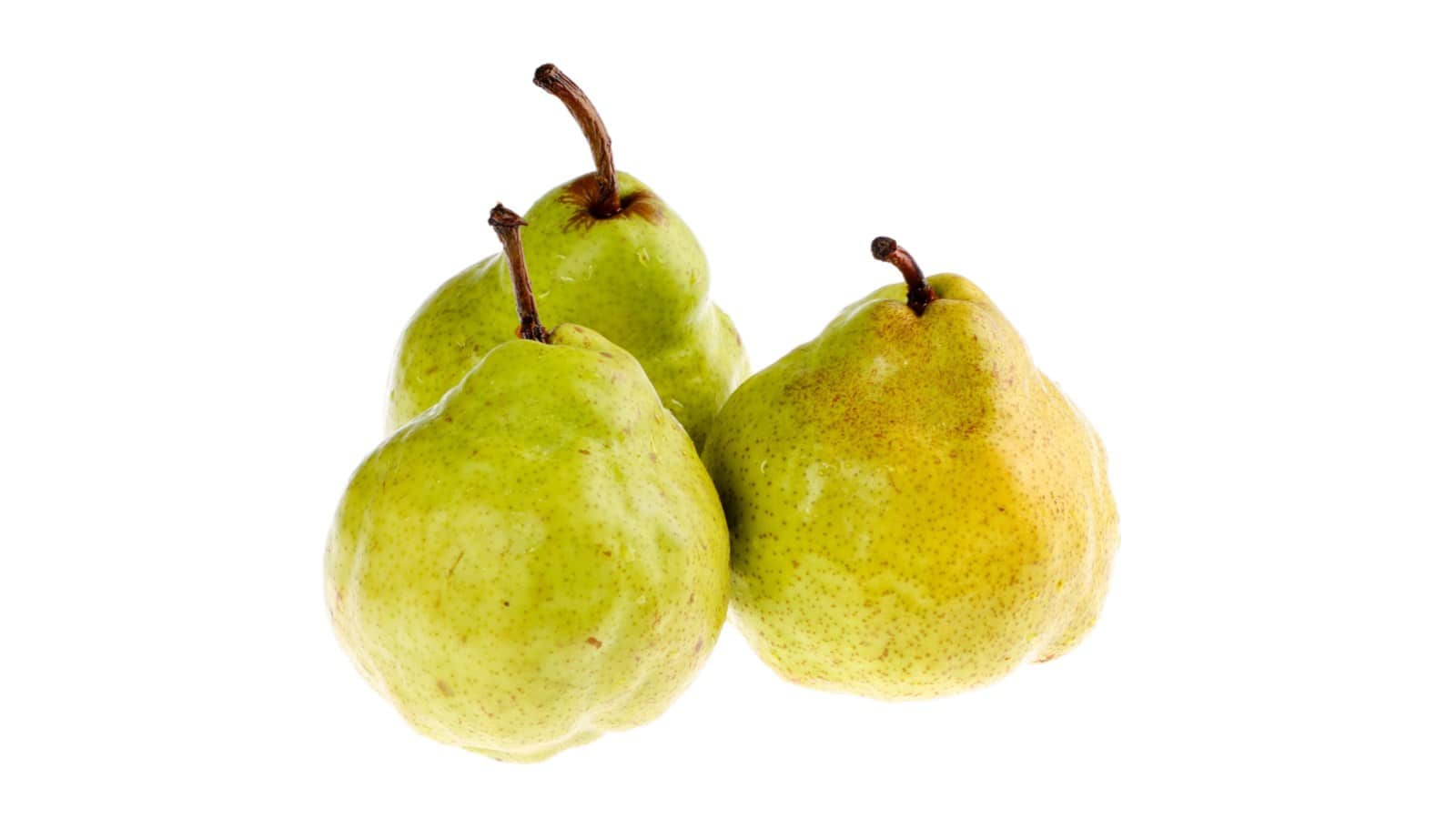
- Botanical Name:Pyrus communis ‘D’Anjou’
- USDA Hardiness Zones: 5-8
- Mature Size: 12-20 feet tall, 10-15 feet wide
- Light: Full sun to partial shade
- Soil: Well-drained, loamy soil
D’Anjou pears, or Anjou or Beurré d’Anjou, are easily recognizable by their squat, egg-shaped appearance and green to yellow skin. Unlike other pear varieties, D’Anjou pears do not change color significantly as they ripen. They have a dense, smooth texture and a mildly sweet flavor, making them a favorite for fresh eating and cooking. D’Anjou pears are known for their resistance to bruising, allowing for easy transportation and handling.
Bosc Pear
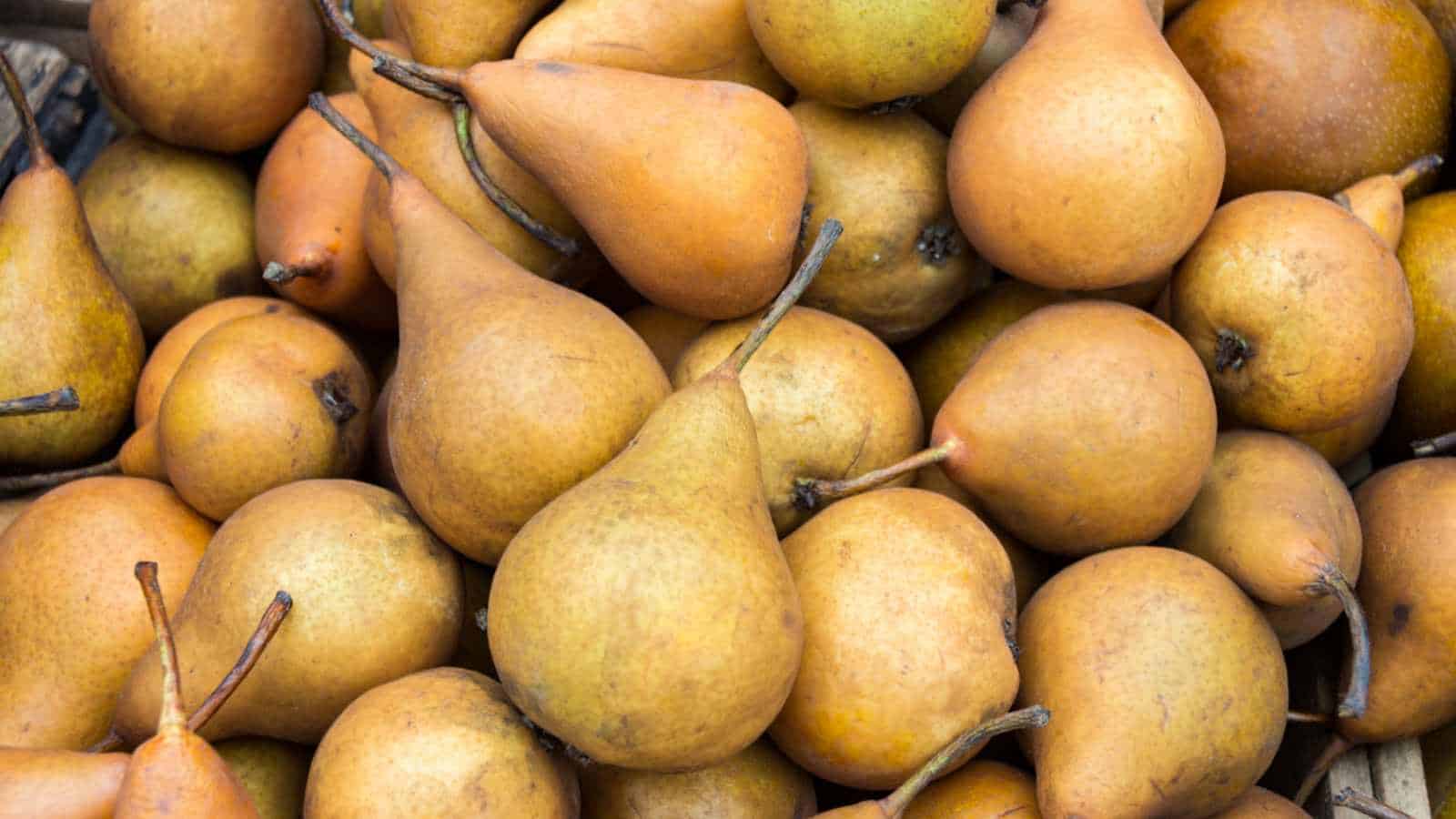
- Botanical Name: Pyrus communis ‘Bosc’
- USDA Hardiness Zones: 5-7
- Mature Size: 12-20 feet tall, 10-15 feet wide
- Light: Full sun
- Soil: Well-drained, sandy-loam soil
Bosc pears are renowned for their unique appearance – a long, tapering neck and russeted, brownish-gold skin. The flesh of Bosc pears is dense and firm, with a rich, honey-like flavor. These pears maintain their shape well when cooked, making them ideal for baking, poaching, and grilling. Bosc pears ripen from the inside out, so their flesh becomes tender before the skin changes significantly. Their sweet taste and firm texture make them a favorite for various culinary applications.
Summercrisp Pear
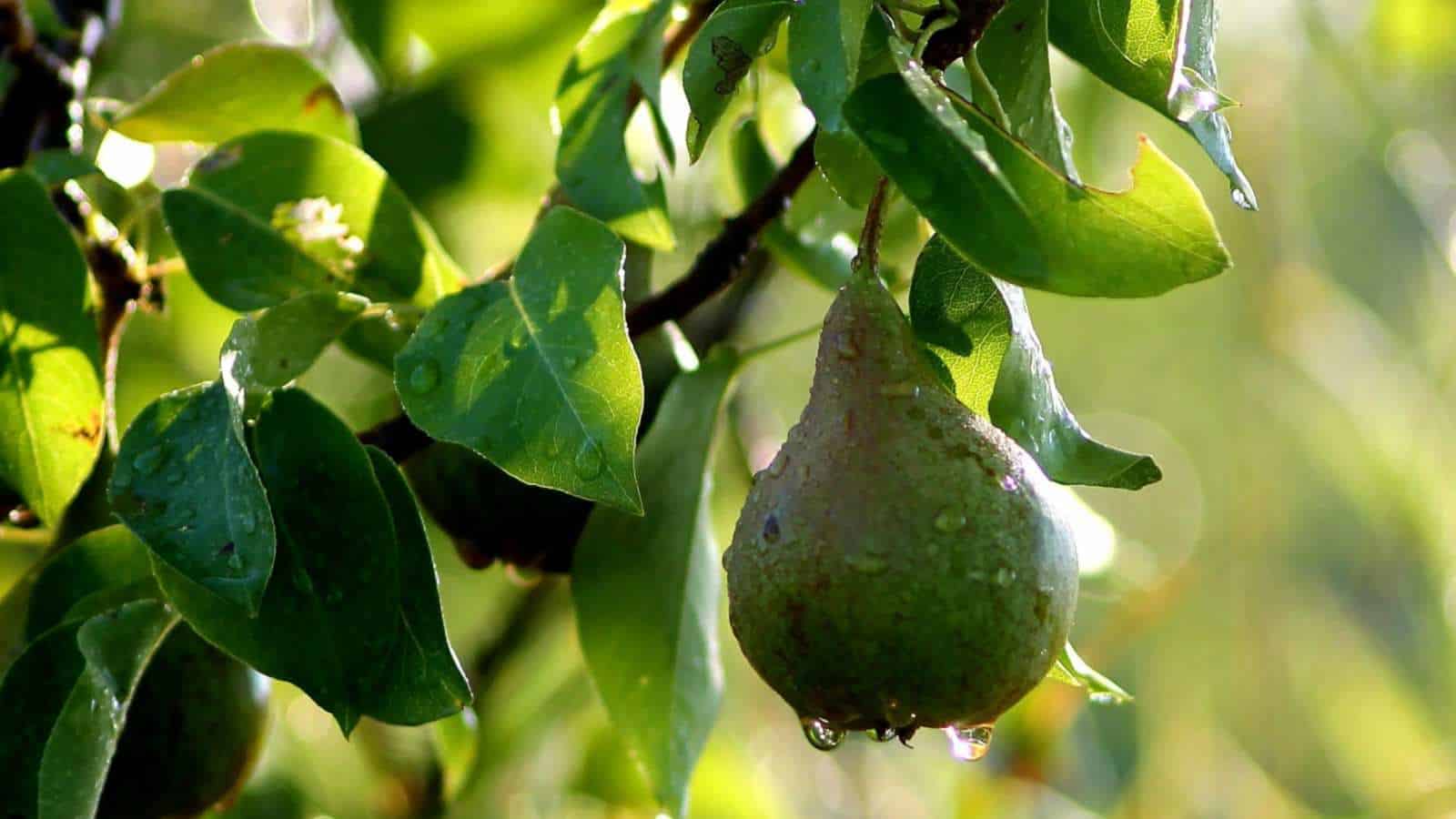
- Botanical Name: Pyrus communis ‘Summercrisp’
- USDA Hardiness Zones: 4-8
- Mature Size: 12-15 feet tall, 8-12 feet wide
- Light: Full sun
- Soil: Well-drained, loamy soil
Summercrisp pears are aptly named for their crisp, crunchy texture. They have a mild, sweet flavor and are perfect for fresh snacking. These crisp fruit pears are particularly suited for cooler climates.
Moonglow Pear
- Botanical Name: Pyrus communis ‘Moonglow’
- USDA Hardiness Zones: 5-8
- Mature Size: 15-20 feet tall, 12-15 feet wide
- Light: Full sun
- Soil: Well-drained, loamy soil
Moonglow pears are known for their smooth, yellow skin and juicy, sweet taste. They are great for fresh eating and canning. These trees thrive in moderate climates.
Shinko Pear
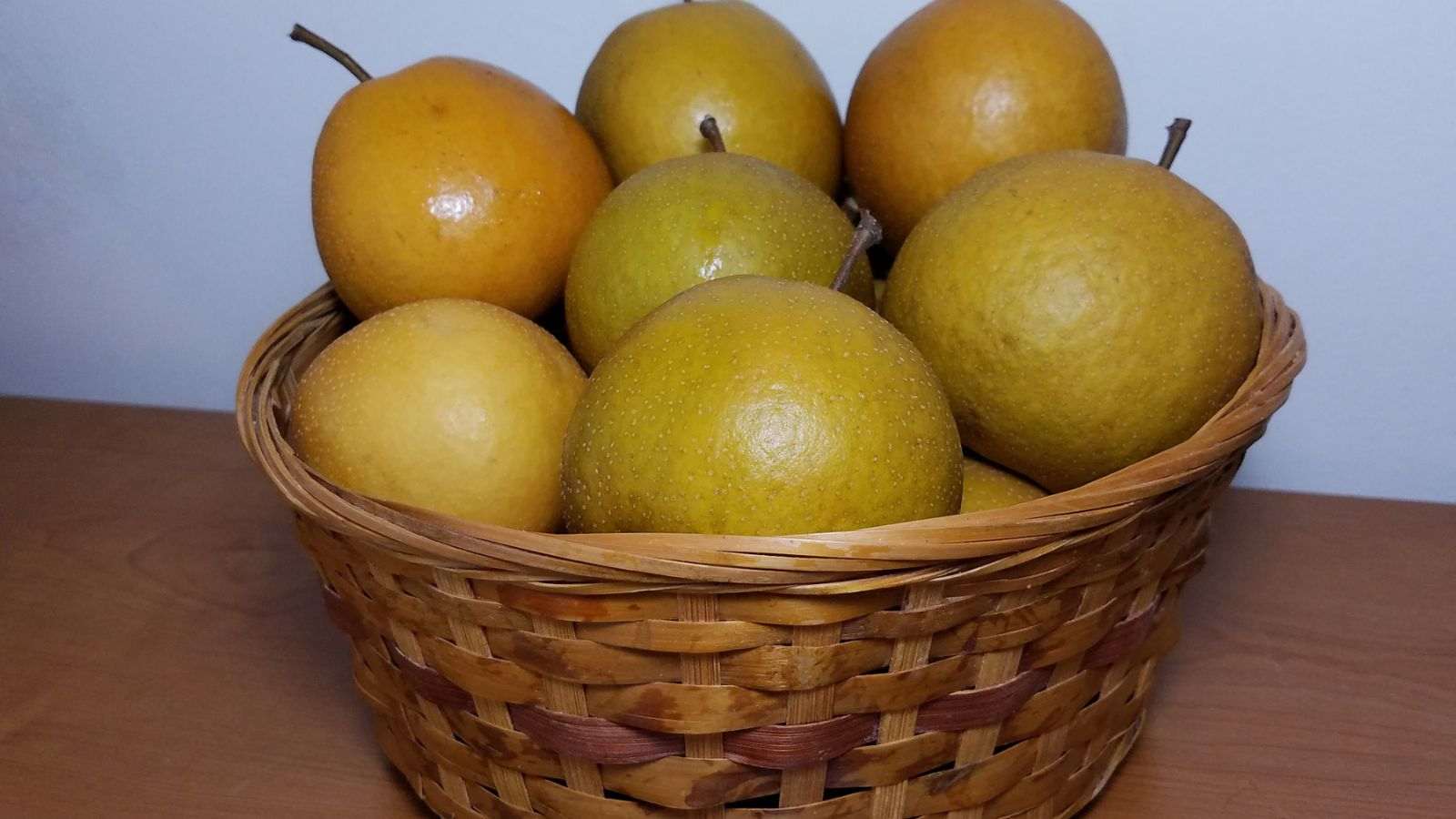
- Botanical Name:Pyrus pyrifolia ‘Shinko’
- USDA Hardiness Zones: 5-9
- Mature Size: 15-20 feet tall, 10-15 feet wide
- Light: Full sun to partial shade
- Soil: Well-drained, fertile soil
Shinko pears, or Asian pears, are crisp and juicy with a sweet, refreshing flavor. They are excellent for fresh consumption and have a russeted, tan skin.
Shinseiki Pear
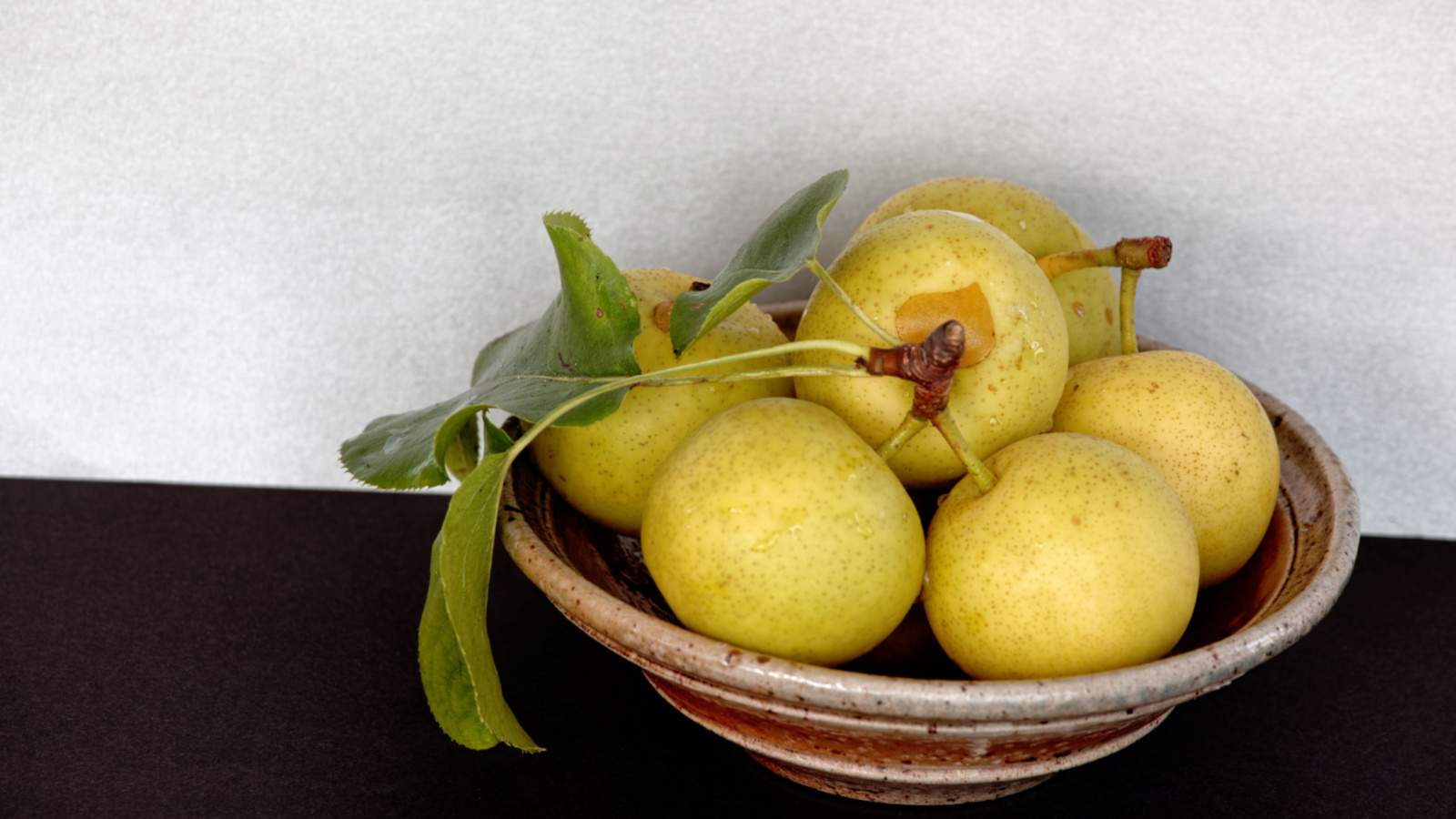
- Botanical Name:Pyrus pyrifolia ‘Shinseiki’
- USDA Hardiness Zones: 5-9
- Mature Size: 12-15 feet tall, 10-12 feet wide
- Light: Full sun
- Soil: Well-drained, fertile soil
Shinseiki pears are another variety of Asian pears. They have a round shape and crisp texture, with a sweet, slightly tart flavor. They are delicious for snacking and fresh salads.
Flordahome Pear
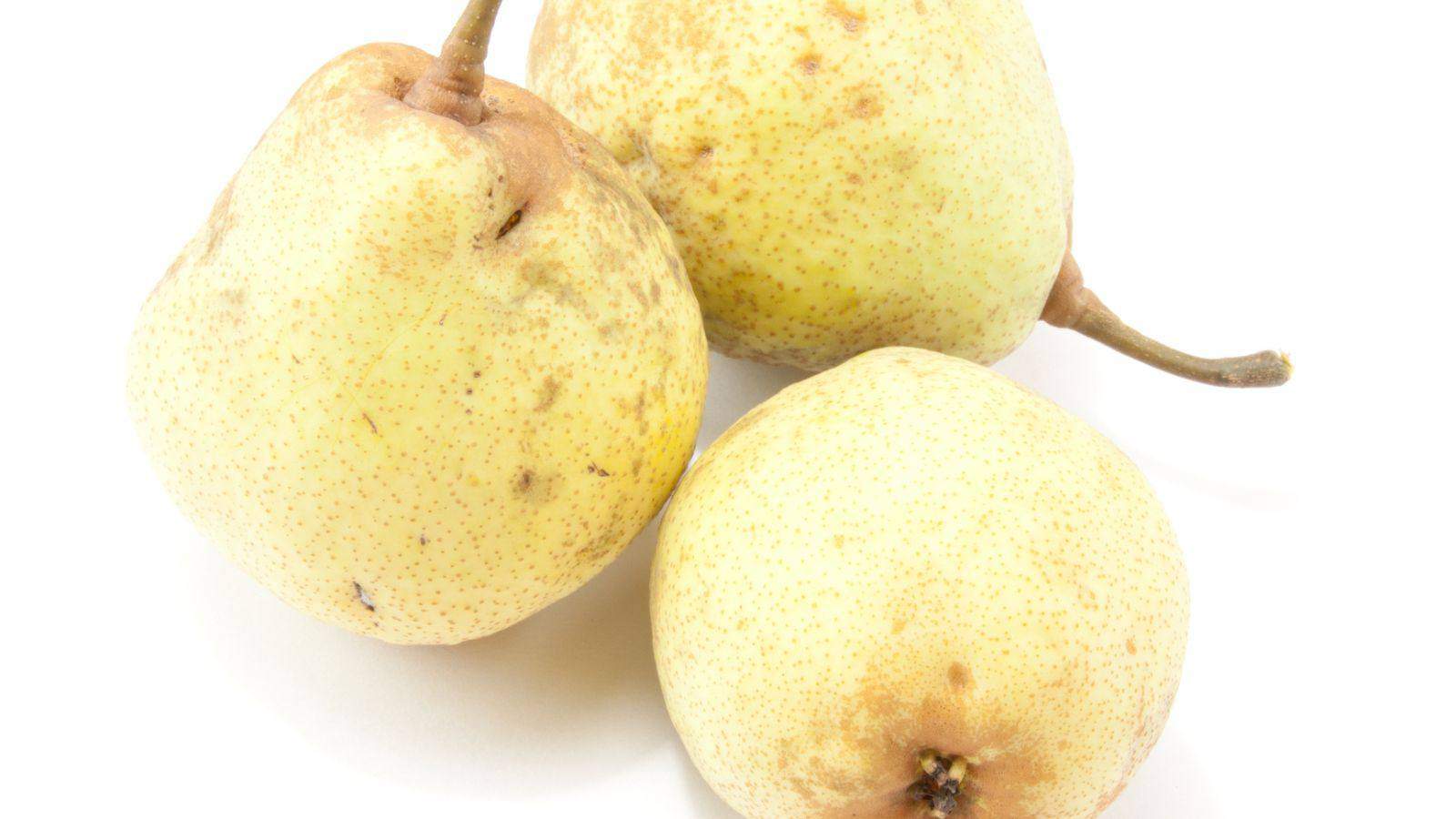
- Botanical Name: Pyrus calleryana ‘Flordahome’
- USDA Hardiness Zones: 7-10
- Mature Size: 15-25 feet tall, 10-15 feet wide
- Light: Full sun
- Soil: Well-drained, adaptable to various soil types
Flordahome pears are suitable for warm climates. They have a mild, sweet flavor and are good for fresh eating and cooking.
Seckel Pear
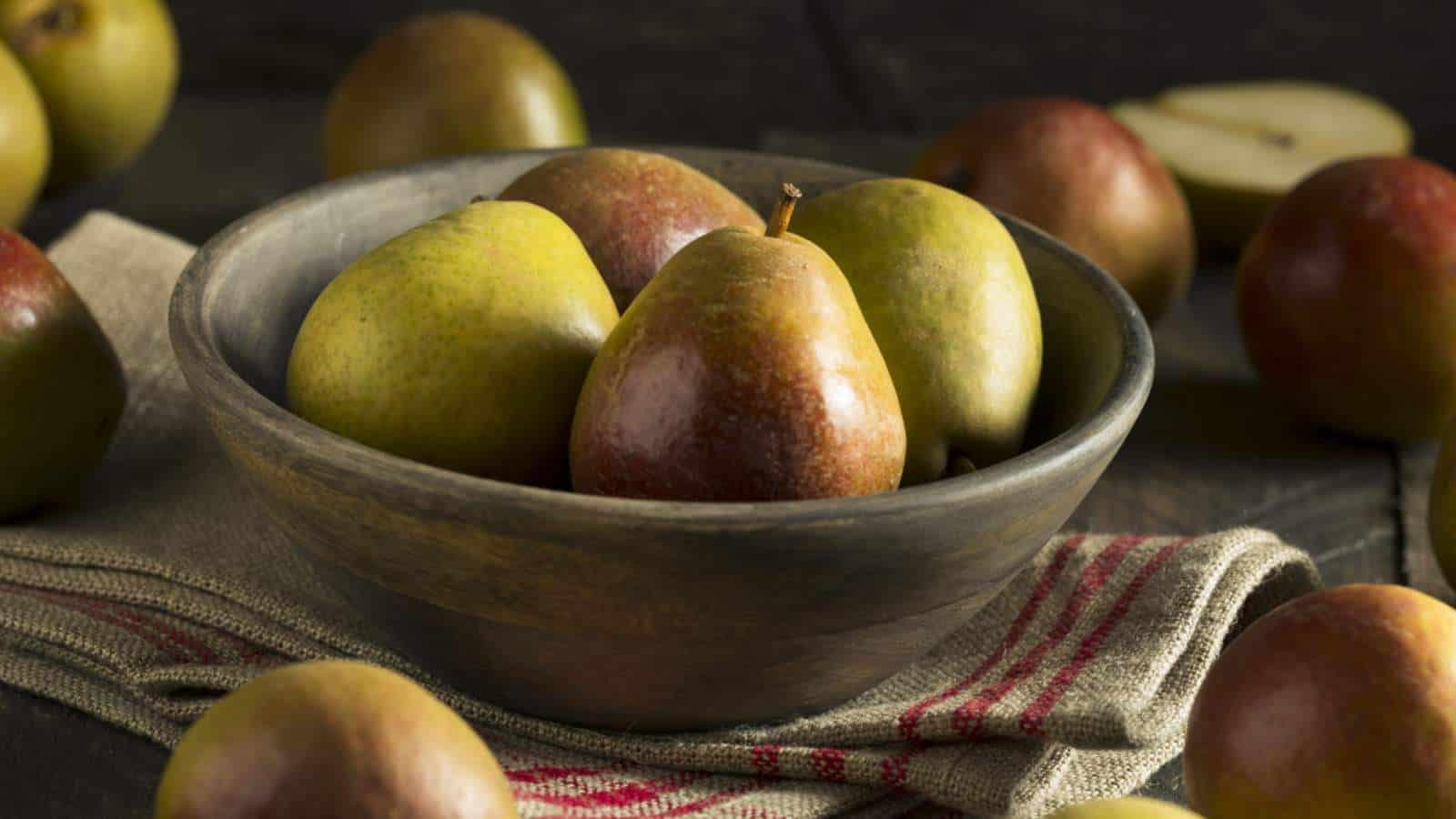
- Botanical Name: Pyrus communis ‘Seckel’
- USDA Hardiness Zones: 4-8
- Mature Size: 10-15 feet tall, 8-12 feet wide
- Light: Full sun to partial shade
- Soil: Well-drained, fertile soil
Seckel pears are known for their small size and unique, sweet, and spicy flavor. They are perfect for fresh snacking and adding to cheese plates.
Comice Pear

- Botanical Name: Pyrus communis ‘Comice’
- USDA Hardiness Zones: 5-8
- Mature Size: 12-20 feet tall, 10-15 feet wide
- Light: Full sun
- Soil: Well-drained, loamy soil
Comice pears are often called the “Christmas pear” due to their popularity during the holiday season. They have a round shape, pale green to yellow skin, and a red blush. These pears are known for their exceptionally juicy, sweet, and aromatic flesh, making them a gourmet delight. They are perfect for enjoying fresh or paired with cheese and wine.
Harrow Sweet Pear
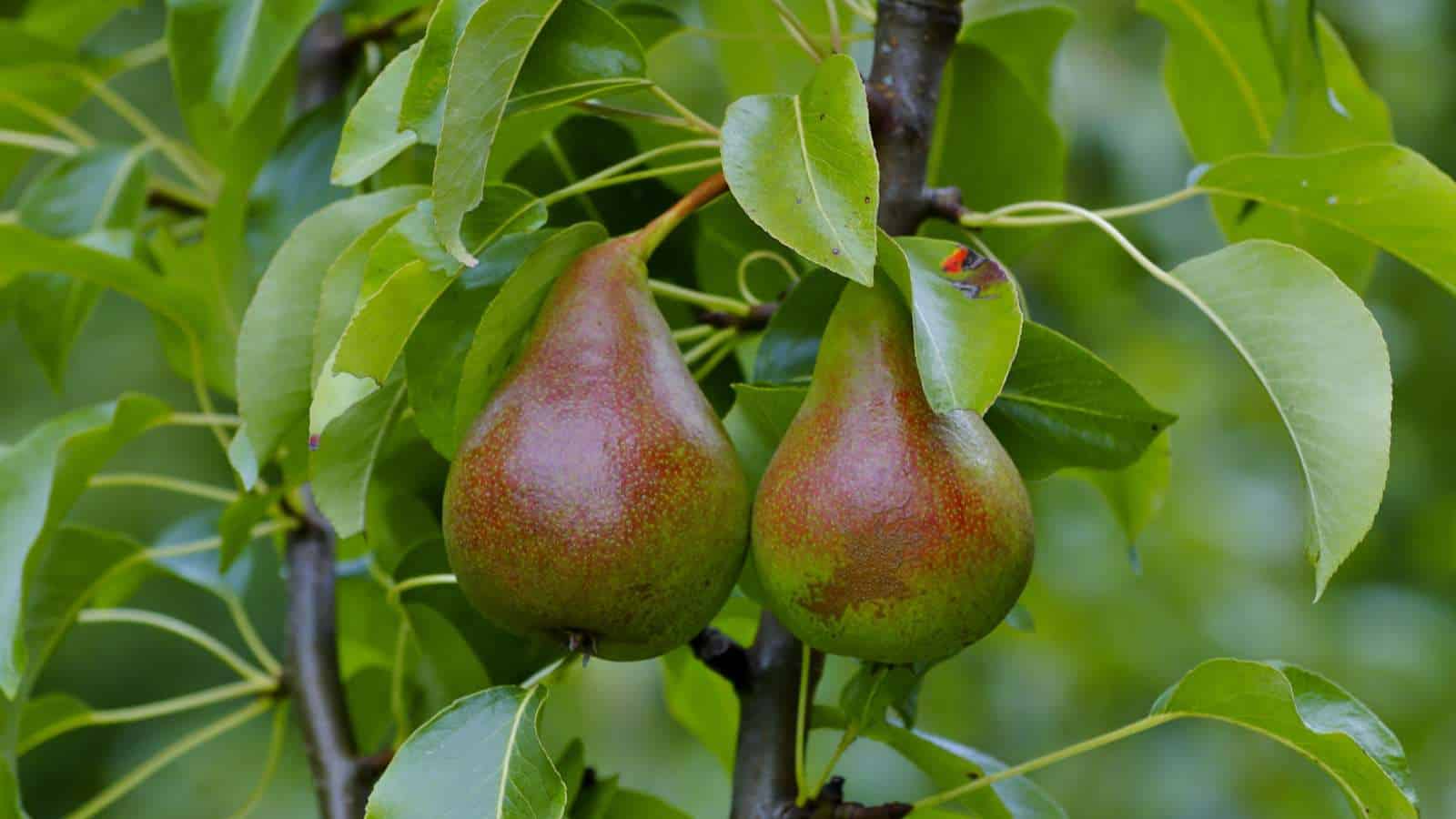
- Botanical Name: Pyrus communis ‘Harrow Sweet’
- USDA Hardiness Zones: 4-8
- Mature Size: 15-20 feet tall, 10-15 feet wide
- Light: Full sun
- Soil: Well-drained, fertile soil
Harrow Sweet pears are medium-sized, with smooth, golden-yellow skin and tender, sweet flesh. They are perfect for fresh eating and desserts, boasting a delightful combination of sweetness and juiciness. These pears ripen in late summer, making them a wonderful addition to your orchard.
Honeysweet Pear

- Botanical Name: Pyrus communis ‘Honeysweet’
- USDA Hardiness Zones: 5-8
- Mature Size: 15-20 feet tall, 12-15 feet wide
- Light: Full sun
- Soil: Well-drained, loamy soil
Honeysweet pears are known for their exceptionally sweet flavor and juicy texture. They have smooth, thin skin and creamy flesh, making them a favorite for fresh snacking and desserts. These pears resist fire blight, adding to their appeal for home gardeners.
How to Plant Pear Tree From Seed
Ever wondered if you could grow your pear tree from a simple seed? Well, wonder no more because I’m here to guide you through the fascinating journey of planting a pear tree from scratch. It might sound daunting, but trust me, with patience and care, you’ll soon have your pear tree flourishing in your garden. So, grab your gardening gloves, and let’s get started!
Step 1: Preparing the Seed
Grab a ripe pear and collect the seeds. Clean them thoroughly, removing any flesh or residue. Next, it’s time for a little winter magic – place your seeds in a damp paper towel, seal them in a plastic bag, and pop them in the fridge for about 2-3 months. This process, known as stratification, mimics the cold winter conditions these seeds need to sprout successfully.
Step 2: Planting the Seed
Once your seeds have had their chilly nap, it’s time to plant them. Choose a pot with well-draining soil and plant the seeds about an inch deep. Be gentle; these little guys are delicate! Now, place the pot in a sunny spot, ensuring the soil stays consistently moist. It might take a while, but with patience, you’ll see tiny green shoots emerging – a sign that your pear tree is on its way!
Step 3: Providing the Right Conditions
Pear trees, like any living beings, have their preferences. Make sure your young seedling gets plenty of sunlight. Full sun is their jam! Also, keep an eye on the moisture level in the soil. Pear trees love their water, but they don’t like to sit in soggy ground, so well-draining soil is essential. Regular watering, especially during dry spells, will keep your tree happy and hydrated.
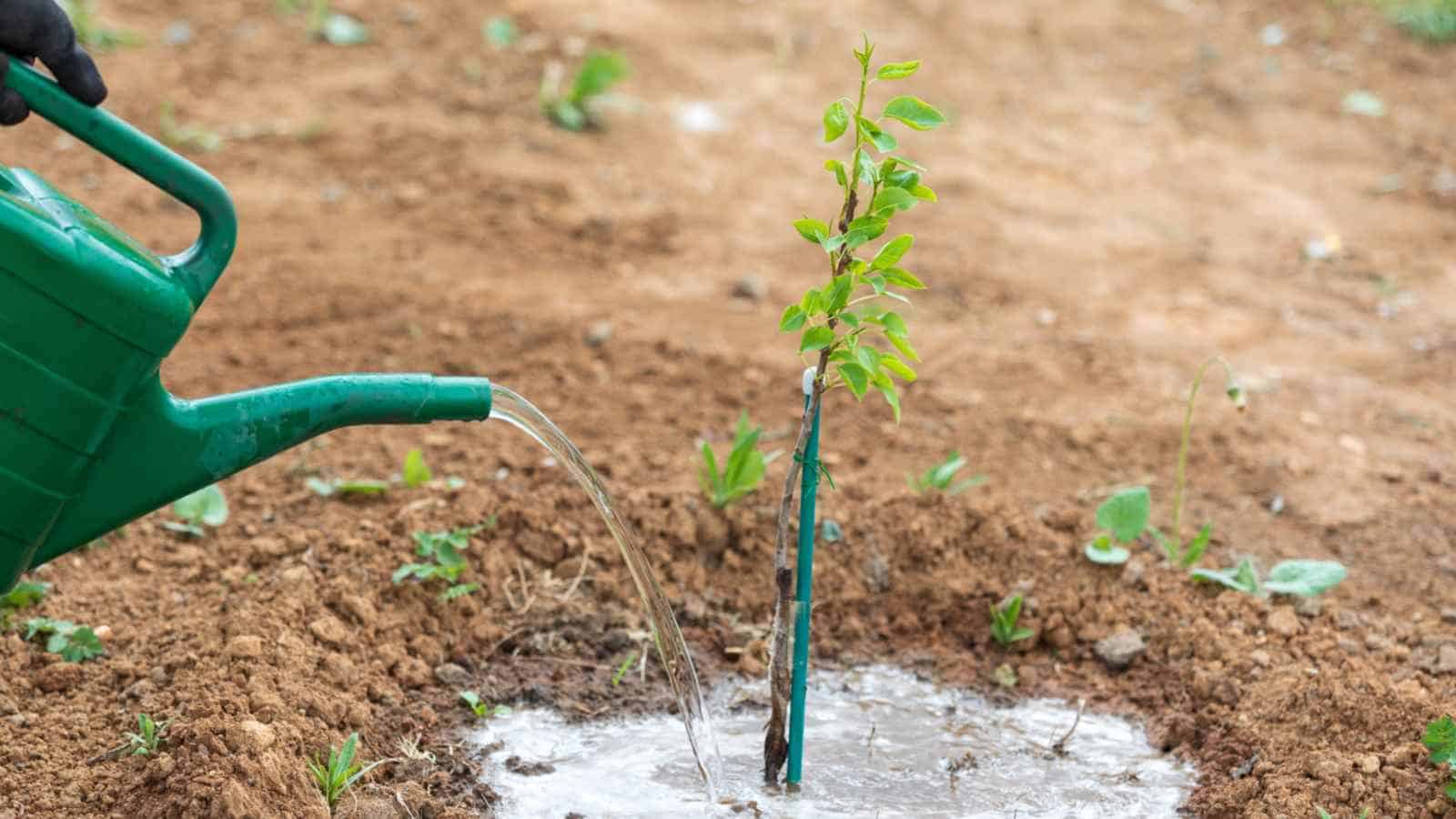
Step 4: Addressing Common Pests and Problems
As your pear tree grows, watch for common pests like aphids and caterpillars. They might try to nibble on your precious leaves. Fear not – natural solutions like neem oil or introducing beneficial insects can help keep these intruders at bay. Also, watch for signs of diseases such as powdery mildew. Proper air circulation and avoiding overhead watering can minimize the risk.
Step 5: Flowering and Aftercare
Now, here’s the exciting part: flowering! You’ll witness a breathtaking sight when your pear tree starts to bloom. Those delicate blossoms will transform into future fruits. Bees and other pollinators are your best friends here, so encourage their presence in your garden. As your tree matures, consider pruning to maintain its shape and encourage healthy growth. Regular feeding with a balanced fertilizer in the growing season will ensure your pear tree has all the nutrients it needs.
And there you have it, your very own pear tree grown from a humble seed! Remember, gardening is as much about patience as it is about care. Enjoy the process, marvel at nature’s wonders, and soon enough, you’ll be relishing the fruits of your labor – literally!
How to Propagate Pear Trees
Selecting a Propagation Method
When it comes to propagating pear trees, you have a couple of fantastic options. One popular method is grafting, combining a shoot (scion) from your desired pear tree variety to an existing rootstock. Alternatively, you can propagate pear trees from cuttings, which involves growing new trees from branches. Both methods have their merits, so choosing the one that suits your expertise and resources is the first step toward successful propagation.
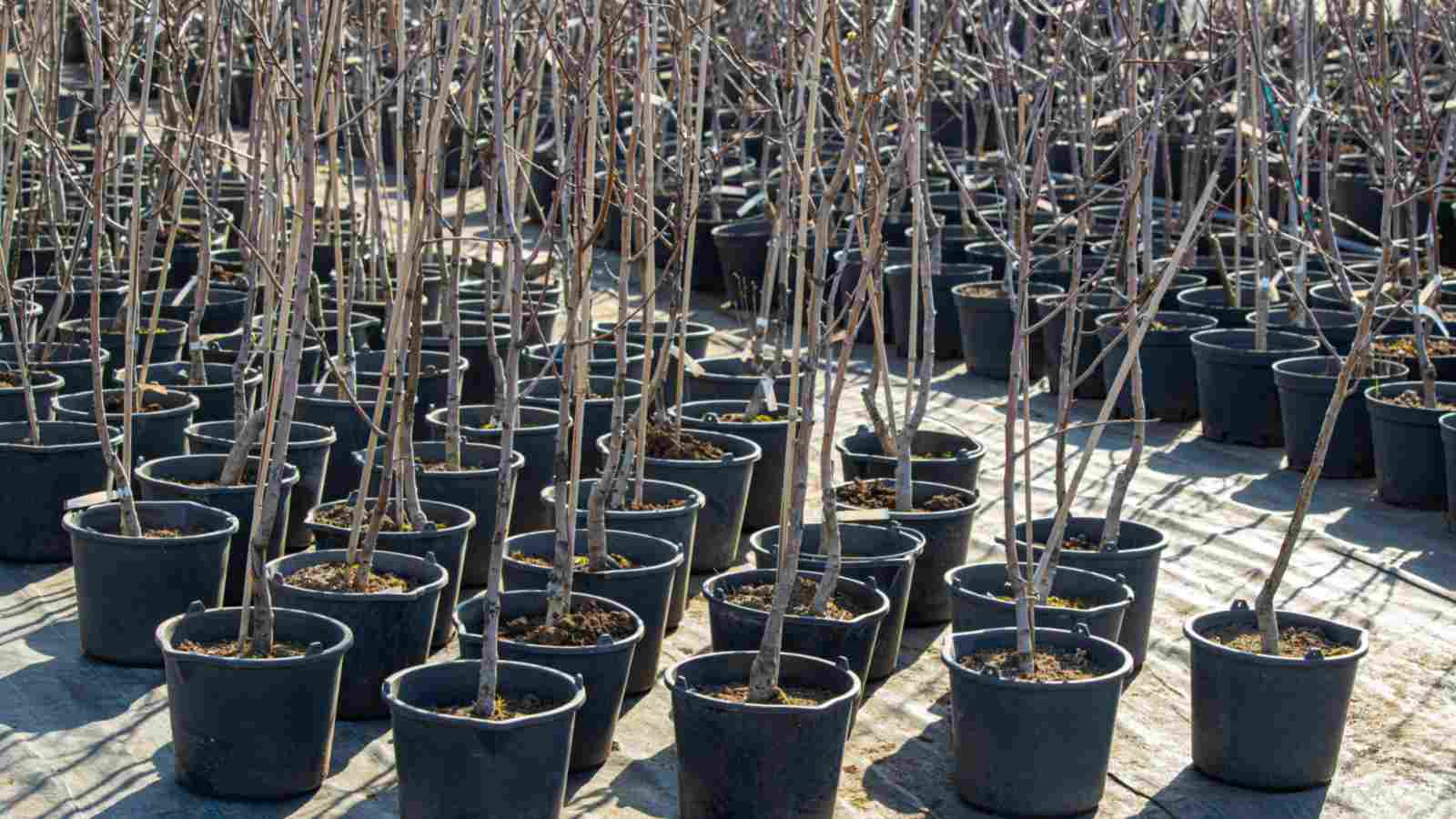
Propagation via Grafting
Grafting, the art of uniting different plant parts to create a new tree, offers a precise way to replicate specific pear tree varieties. Select a healthy, disease-free scion from the pear tree you wish to propagate and graft it onto a compatible rootstock. With careful pruning and attention, your grafted tree will soon flourish, giving you the desired pear variety.
Propagation via Cuttings
If you prefer a more straightforward approach, propagating pear trees from cuttings might be your best bet. Take a healthy, young branch from the parent tree, ensuring it’s around 6 to 8 inches long. Remove the lower leaves and place the cutting in a rooting medium. With the right care and nurturing, the cutting will develop roots into an independent pear tree.
Rooting
Rooting is a critical phase in pear tree propagation. Whether you’ve chosen grafting or cuttings, ensuring the developing plant has a robust root system is essential for its long-term health. Provide a well-draining, nutrient-rich soil mix, stabilize humidity levels, and avoid overwatering. With patience and a watchful eye, you’ll soon witness the birth of a resilient pear tree, ready to thrive in your garden.
Care and Maintenance
Once your newly propagated pear tree is firmly rooted, it’s time for tender loving care. Regular watering, especially during dry spells, is crucial to establish a strong root system. Mulching around the base of the tree helps retain moisture and suppress weeds, fostering a healthy environment for growth. Pruning is also vital; remove dead or diseased branches, ensuring the tree maintains an open canopy for optimal sunlight exposure and air circulation.
Finding a Suitable Location
When it comes to planting your propagated pear tree, location is key. Pear trees thrive in full sun, so choose a spot in your garden that receives at least 6 hours of direct sunlight daily. Well-draining soil is a must to prevent waterlogged roots, ensuring your tree stays healthy and vibrant. Taking the time to find the perfect spot will pay off in bountiful harvests and luscious pears.
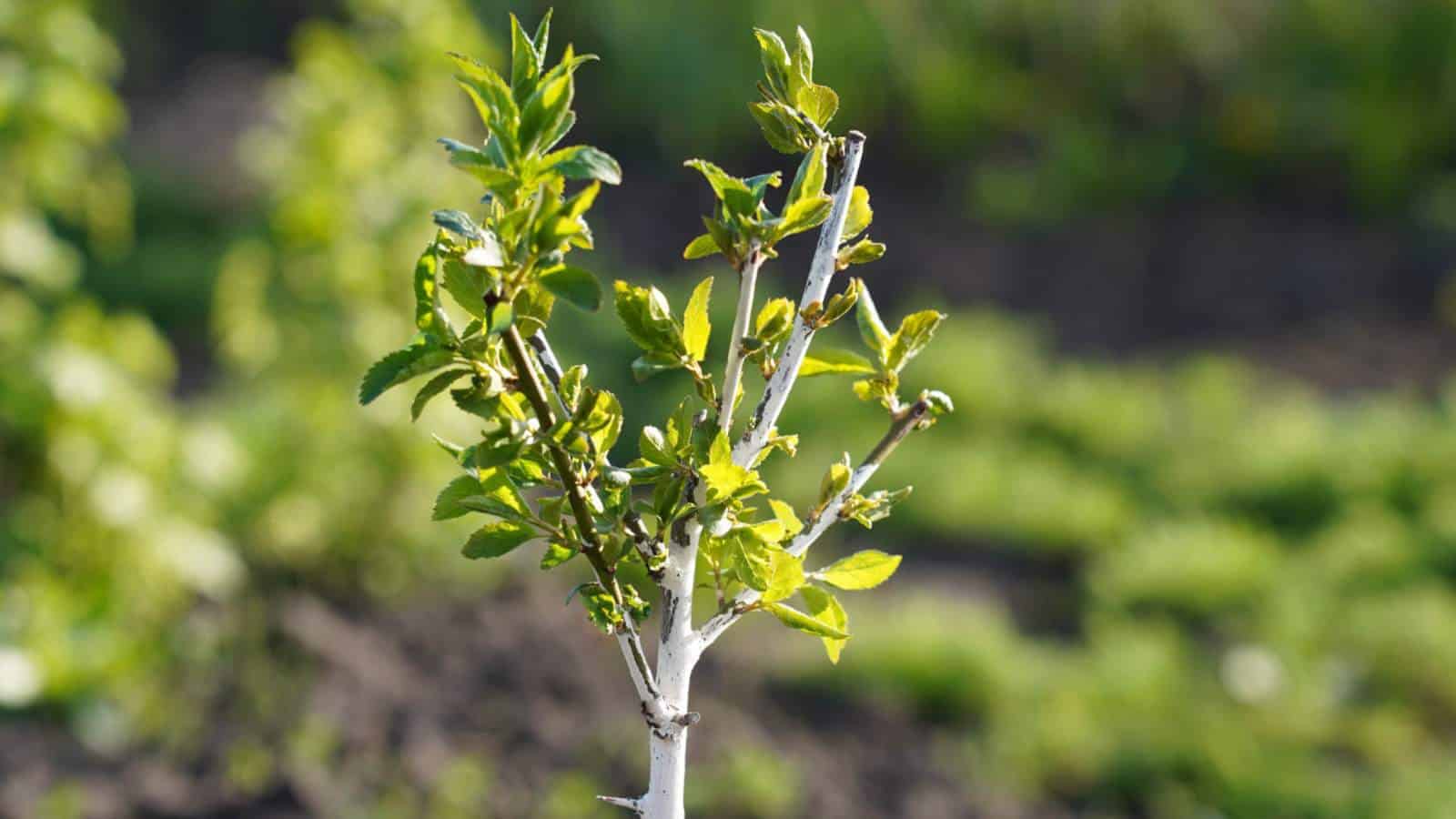
Monitoring for Pests and Diseases
Keep a keen eye out for potential pests and diseases that might threaten your newly propagated pear tree. Regularly inspect the leaves, branches, and fruits for any signs of trouble. Implement natural remedies like neem oil or introduce beneficial insects to keep pests at bay. Proper sanitation, such as removing fallen leaves and fruits, helps prevent disease spread. By staying vigilant and proactive, you’ll ensure your pear tree thrives, producing delectable fruits for years to come.
How to Harvest and Store Pears
Harvesting Ripe Pears
Harvesting pears is an art that involves a delicate balance between timing and gentleness. These luscious fruits need to be plucked at the right moment to ensure their full flavor and sweetness. So, let’s dive into the world of pear harvesting, where your patience and attention to detail will be richly rewarded.
When determining if your pears are ready for harvest, the key is their color and firmness. Different pear varieties have unique hues at their peak ripeness, but in general, a slight change in color from green to yellow or red indicates ripeness. A gentle press near the stem will tell you if the pear is ripe; if it yields slightly, it’s ready to be picked.
To harvest, use a gentle twisting motion when you pick the pear. Avoid pulling, as this can damage the tree. Always handle the pears with care to prevent bruising, which can lead to spoilage during storage. If a pear is still hard but has reached its full color and is beginning to yield slightly to pressure, you can pick it and allow it to ripen indoors at room temperature. Keep in mind that pears ripen from the inside out, so they may still be firm when perfectly ripe.

Storing Pears
Now, onto the art of storing pears. Ideally, pears should be stored at room temperature until they reach your desired ripeness. Once ripe, they can be transferred to the refrigerator to prolong their freshness. If you have an abundance of ripe pears, consider preserving them. Pears can be canned, made into jams, or dried for long-term storage.
When storing pears, keep them separate from strong-smelling fruits, as they tend to absorb odors. You may also choose to store your harvested pears with an apple or banana — fruits that are more prone to releasing ethylene gas, which accelerates the ripening process. Check your stored pears regularly and remove any that show signs of ripening to prevent overripening and spoilage of the entire lot.
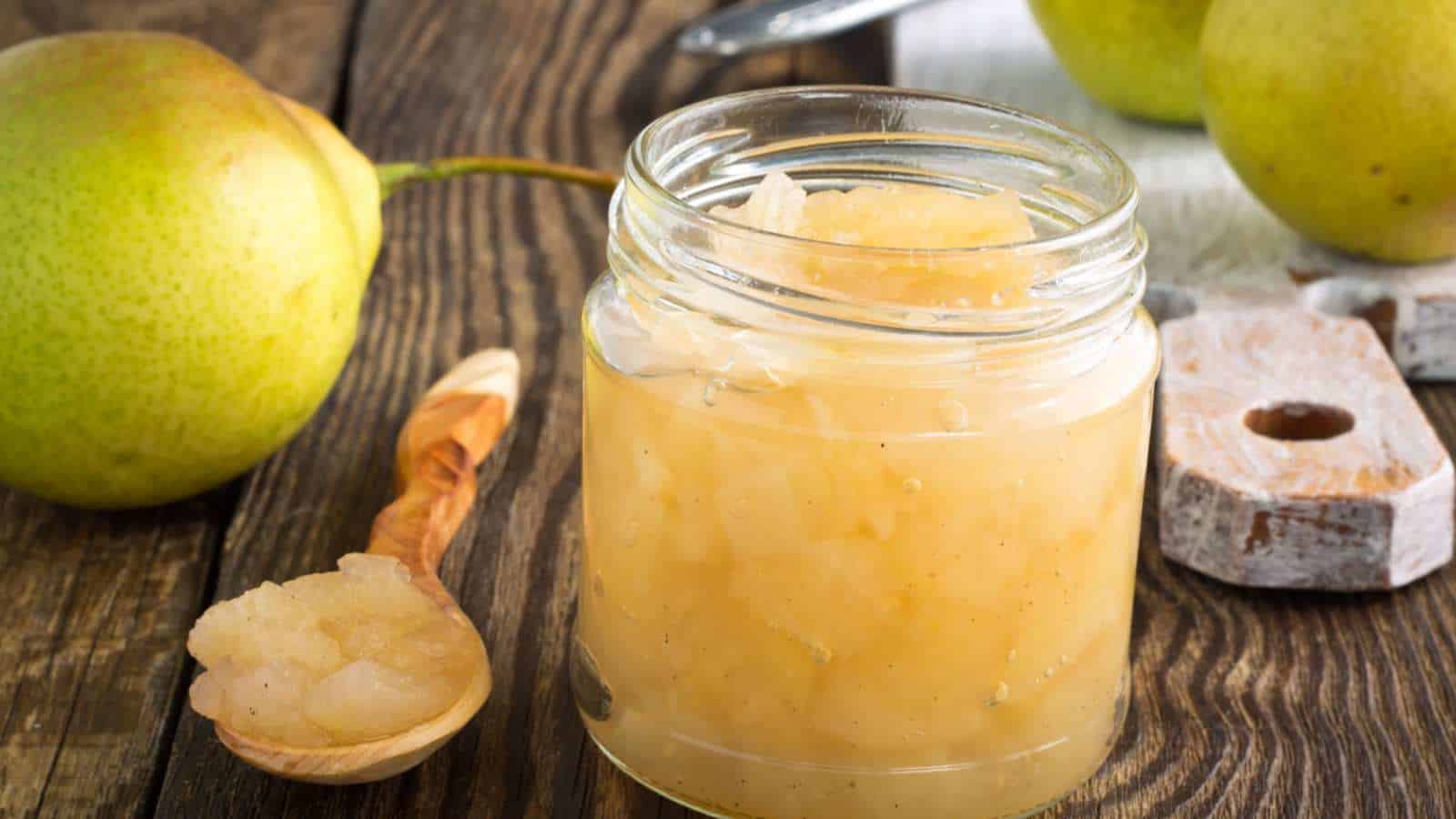
Common Pests and Plant Diseases for Pear Tree
Ah, the joys of tending to your garden can sometimes come with challenges, especially when it comes to pear trees. Let’s delve into the world of common pests and plant diseases that might threaten your beloved pear tree. Armed with knowledge, you can protect your tree and ensure a fruitful harvest.
Aphids

Aphids, those minuscule, sap-sucking insects, can wreak havoc on pear trees. These little troublemakers gather on the leaves and tender shoots, causing them to distort and turn yellow. Aphids not only weaken the tree but also excrete a sticky substance known as honeydew, which promotes the growth of sooty mold. Combat these critters by spraying your tree with a strong jet of water, introducing natural predators like ladybugs, or using insecticidal soap.
Fire Blight
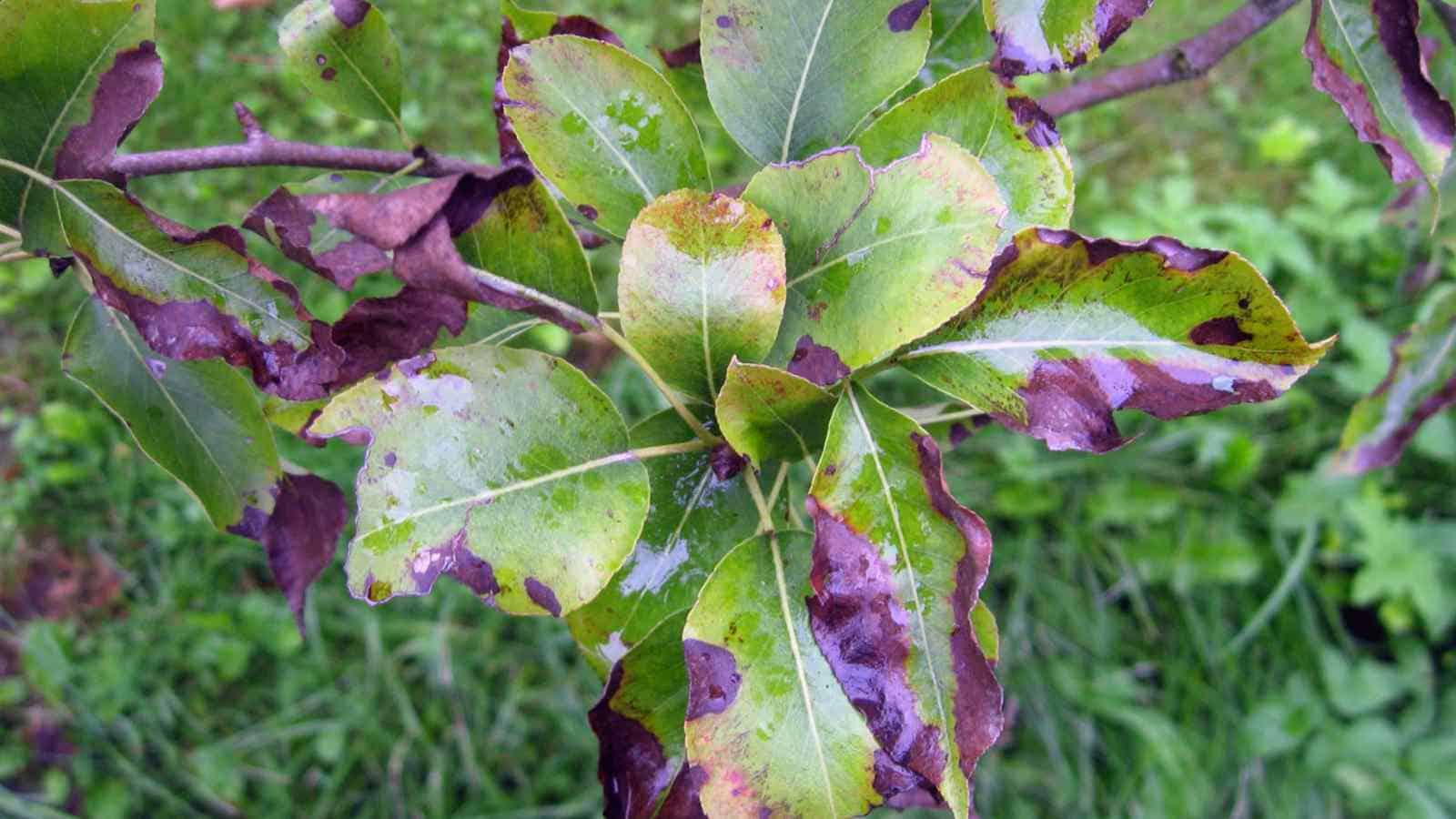
Fire blight, caused by the bacterium Erwinia amylovora, is a nightmare for pear trees. This disease leads to wilting, blackening, and a scorched appearance in blossoms, shoots, and branches. To prevent its spread, promptly prune infected parts and sanitize your pruning tools. Copper-based fungicides applied during the dormant season can offer protection, but the key is vigilance; remove affected branches promptly and dispose of them far from your garden.
Pear Rust
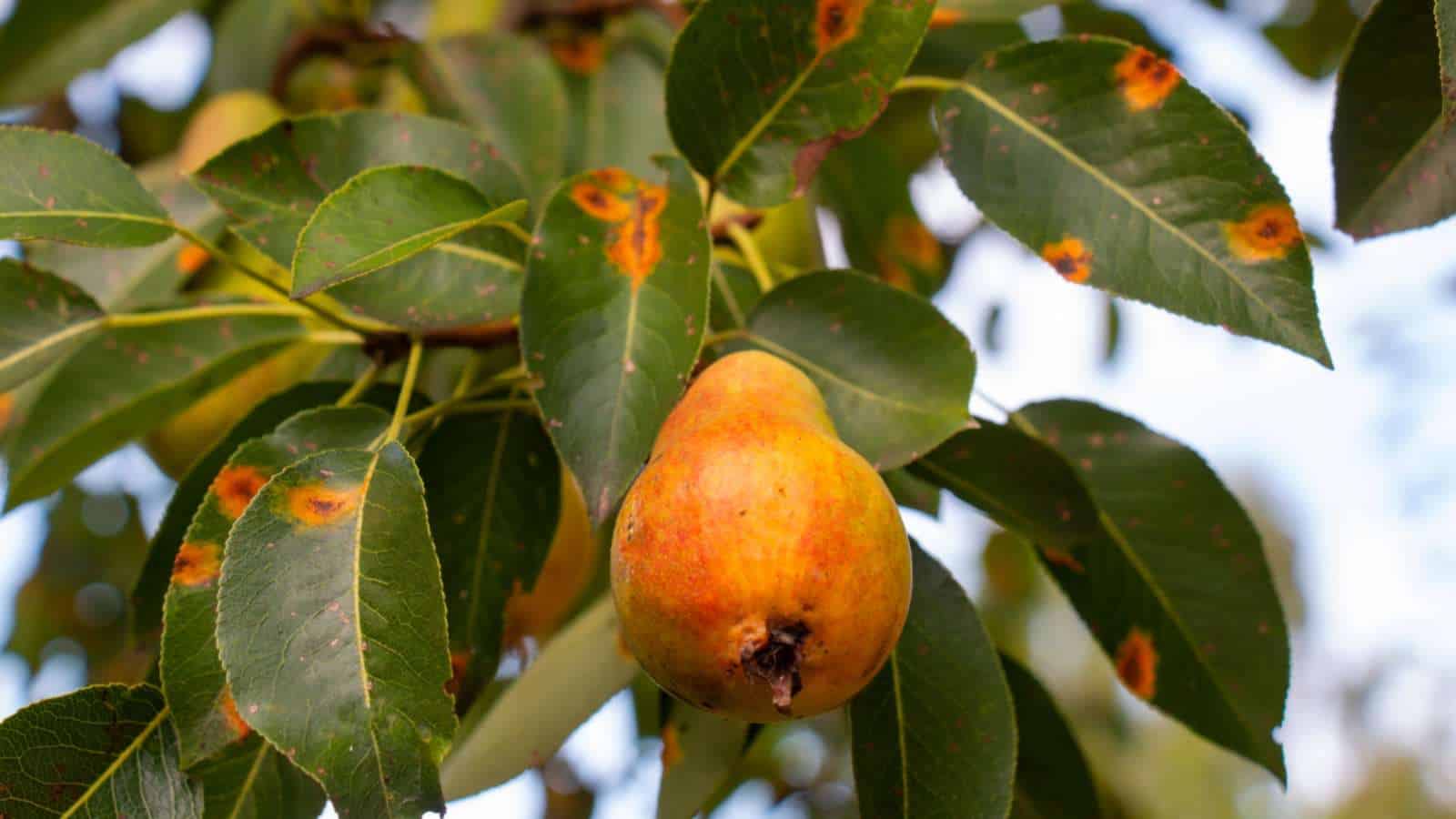
Pear rust, caused by the fungus Gymnosporangium sabinae, creates intriguing orange spots on pear leaves. It’s a fascinating sight but a potential threat. The fungus, which usually originates from juniper trees, can affect pear trees in humid conditions. To combat pear rust, ensure proper air circulation around your tree by pruning neighboring plants. Fungicidal sprays containing copper can also prevent its spread. Regular inspections and quick action are your best allies against this artistic yet troublesome disease.
Codling Moths
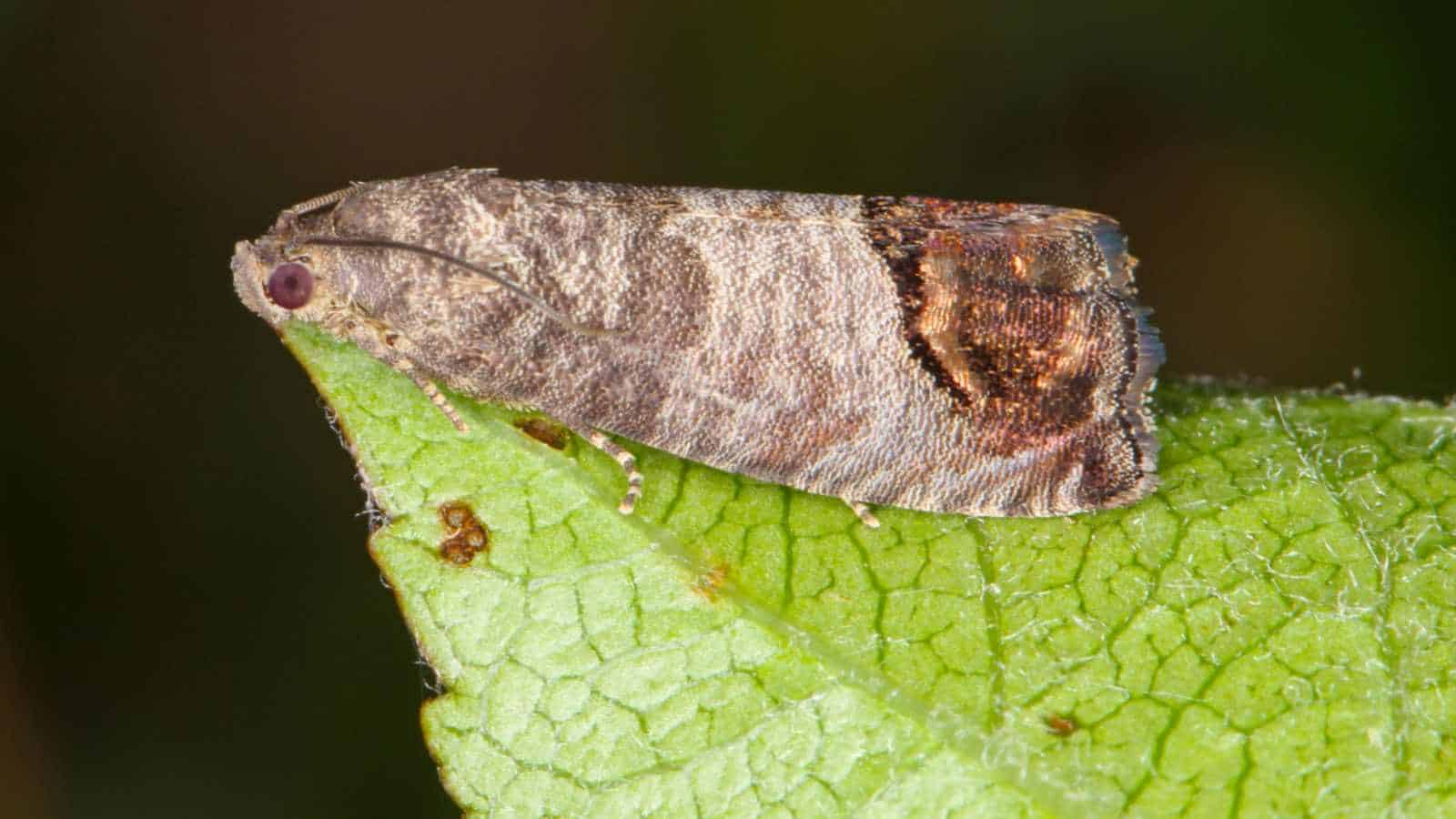
These sneaky creatures target the fruit directly. Their larvae tunnel into the pears, leaving behind a trail of destruction. To protect your harvest, place pheromone traps in your garden to disrupt their mating cycles. Wrapping the developing fruits in special bags can also safeguard them from these insidious invaders. Natural predators like birds and beneficial insects can be encouraged to keep the codling moth population in check.
Powdery Mildew
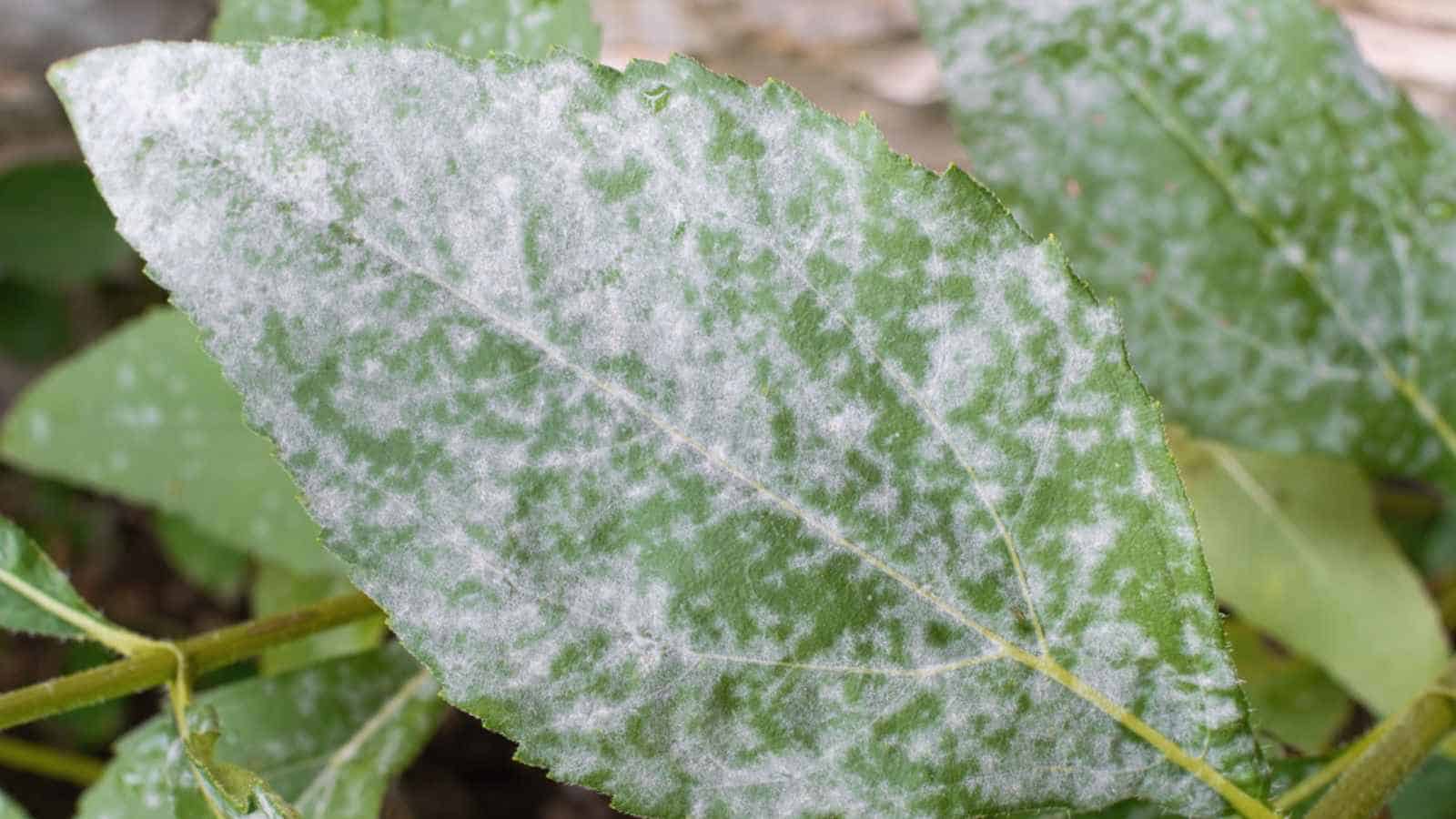
Powdery mildew, the ghostly white substance you sometimes spot on leaves, is caused by various fungi. It weakens the pear tree by inhibiting photosynthesis and stunting growth. Pruning to ensure good air circulation, regular applications of neem oil or sulfur-based fungicides, and choosing disease-resistant pear varieties can help you ward off this eerie foe.
Common Plant Problems and Solutions for Pear Tree
Pear trees, while resilient, sometimes face challenges that can affect their health and productivity. Let’s explore these common plant problems and discover practical solutions to keep your pear tree thriving and bearing delicious fruits.
Lack of Fruit Production
One of the most frustrating issues pear tree owners face is a lack of fruit production. Several factors can contribute, such as poor pollination, inadequate sunlight, or nutrient deficiencies. To address this, consider planting more than one pear tree to ensure cross-pollination, providing at least six hours of sunlight daily, and fertilizing the tree with a balanced fertilizer. Regular pruning also encourages healthy growth and ample fruiting. By addressing these factors, you can encourage your pear tree to yield a bountiful harvest.
Yellowing Leaves

Yellowing leaves on your pear tree can signal various problems, including nutrient deficiencies, water stress, or pests. To pinpoint the issue, assess your tree’s care routine. Ensure it receives appropriate water, especially during dry periods, and feed it with a balanced fertilizer to address nutrient deficiencies. Pests like aphids or spider mites might also be the culprit, so inspect the leaves for signs of infestation. If pests are the problem, consider natural remedies like neem oil or introducing beneficial insects to keep them in check.
Root Rot
Root rot, caused by overly wet soil conditions, can silently threaten your pear tree’s health. Symptoms include wilting, yellowing leaves, and a general decline in the tree’s vigor. To prevent root rot, ensure your pear tree is planted in well-draining soil. Avoid overwatering, especially in clay-heavy soils that retain moisture. Adequate soil drainage is key to keeping the roots healthy. If you suspect root rot, it’s crucial to act swiftly. Improve drainage if necessary and consider fungicidal treatments to combat the disease.
Sunburned Fruit
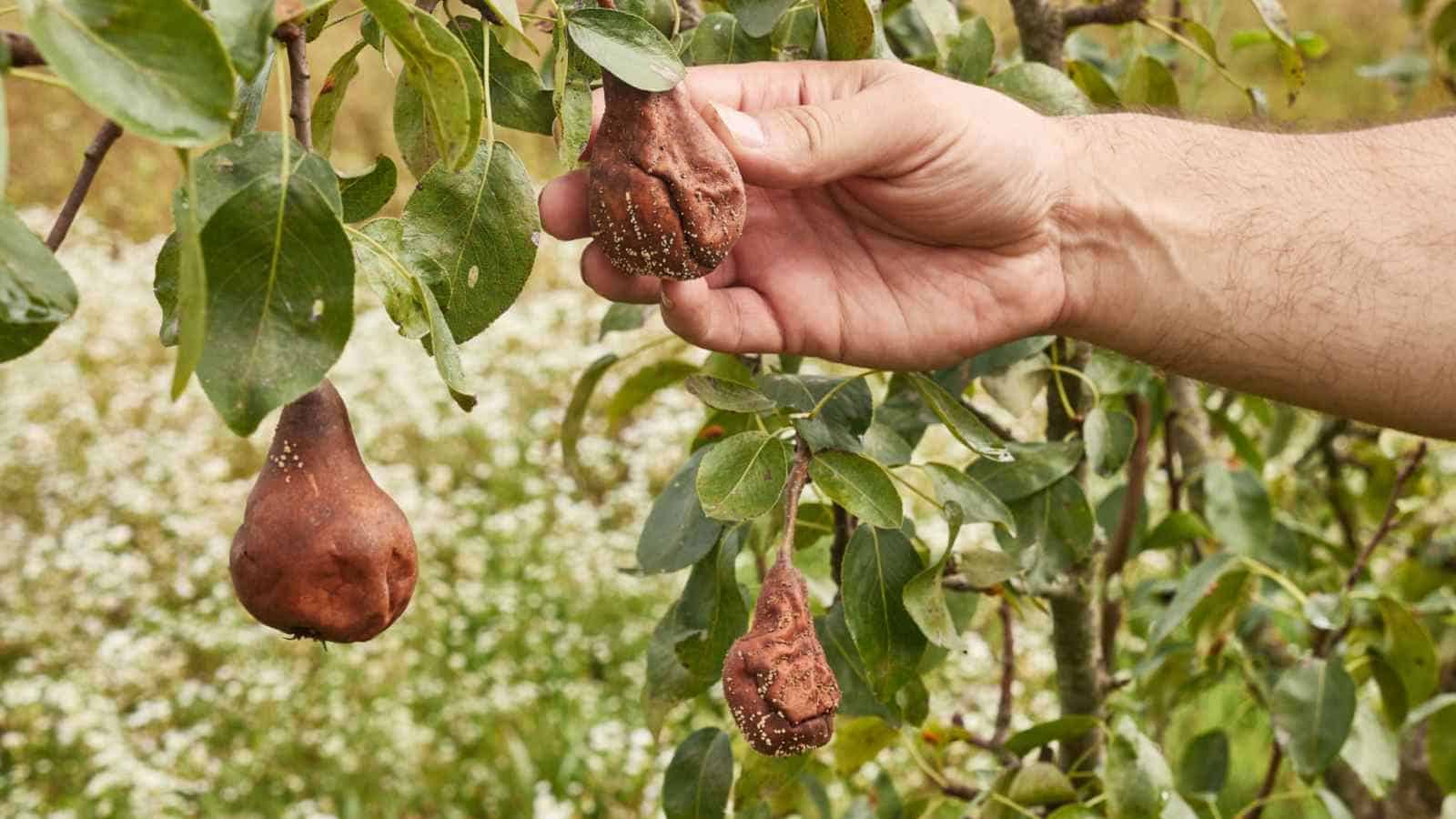
Sunburned fruit can occur during hot summer days, especially on young, tender pears. The scorching sun causes the fruit to develop unsightly brown patches. To shield your pears, consider using lightweight cloth covers or providing temporary shade with umbrellas. Applying a layer of organic mulch around the base of the tree helps retain soil moisture and regulates soil temperature, reducing stress on the fruit. Regular watering, especially during heatwaves, ensures your pear tree remains hydrated, preventing sunburn damage.
Uneven Ripening
Sometimes, pear trees exhibit the quirk of uneven ripening, where some fruits ripen faster than others. This phenomenon often occurs due to varying sunlight exposure or airflow around the tree. To tackle this, prune the tree strategically to allow equal sunlight penetration to all branches. Thin out dense areas to enhance airflow, ensuring consistent ripening. Additionally, keep the tree well-watered and adequately fertilized to support uniform fruit development. By creating balanced conditions, you can enjoy a simultaneous and delicious harvest.
Addressing these common plant problems with practical solutions ensures your pear tree remains healthy and productive. Observing your tree closely, responding promptly to issues, and providing the right care are your best tools in nurturing a flourishing pear tree. Happy gardening!
Other Tree Guides from Planet Natural:











